This seems... very rapid. Especially if there's no sealift capability to bring the army down to the front! That should be a definite -100% to enforcement capability of diplomatic plays from the primary mover. But what do I know.
An Empire Where the Sun Always Rises- A Japan V3 AAR
- Thread starter hjarg
- Start date
-
We have updated our Community Code of Conduct. Please read through the new rules for the forum that are an integral part of Paradox Interactive’s User Agreement.
You are using an out of date browser. It may not display this or other websites correctly.
You should upgrade or use an alternative browser.
You should upgrade or use an alternative browser.
Retooling the Economy
Retooling the Economy
On 1st December of 1836, the first tooling workshop in Edo was completed. Yes, it provided just crude tools. Yes, it was run by shopkeepers, not capitalists. Yes, it wasn’t very effective. It was still the first tooling workshop in Japan.
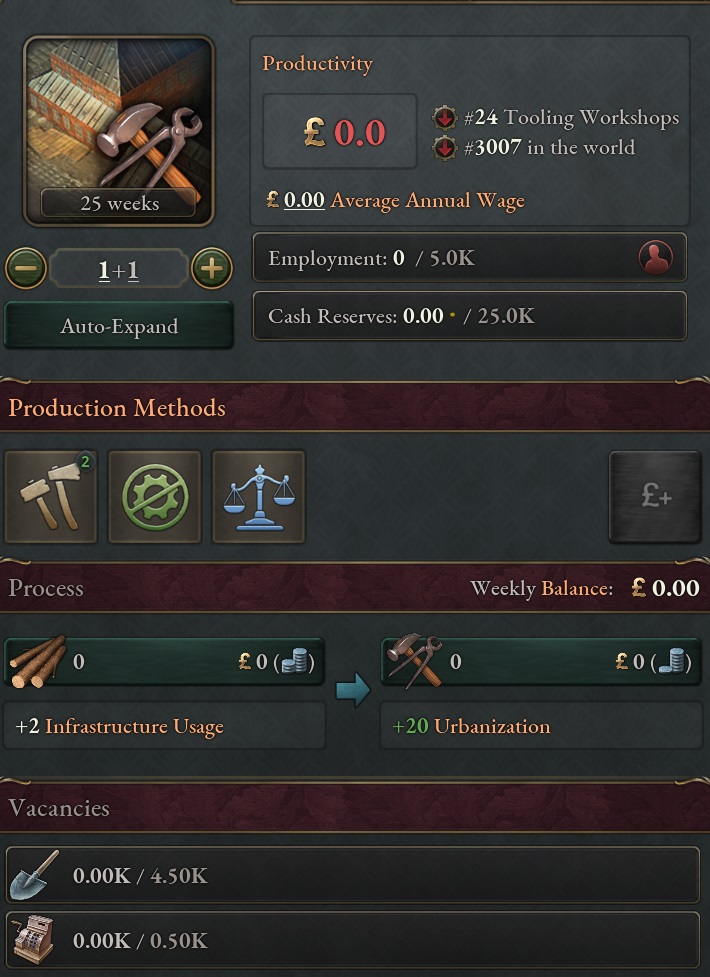
Let the tooling begin
The very same day, the first sawmills in Japan appeared. In Chubu, the first industrial logging camp was set up. Using tools produced in Edo, they were much more efficient in their production than the old-fashioned lumberjacks with axes.
It also created two new classes in Japan. First, of course, were the capitalists. A new power, based on money and manufacturing, not on land and agriculture. A new power to debase the daimyos of Japan and guide the nation to new heights.
There were also the machinists. People trained to operate the machinery. Better-trained than your average laborer, better-paid than your average laborer. More stable jobs, for the machinery needs operators all year round.
The starting was rough, but in a year or so, both new capitalists and machinists were enjoying a life.. Well, lavish one for capitalists and much better quality of life for machinists.
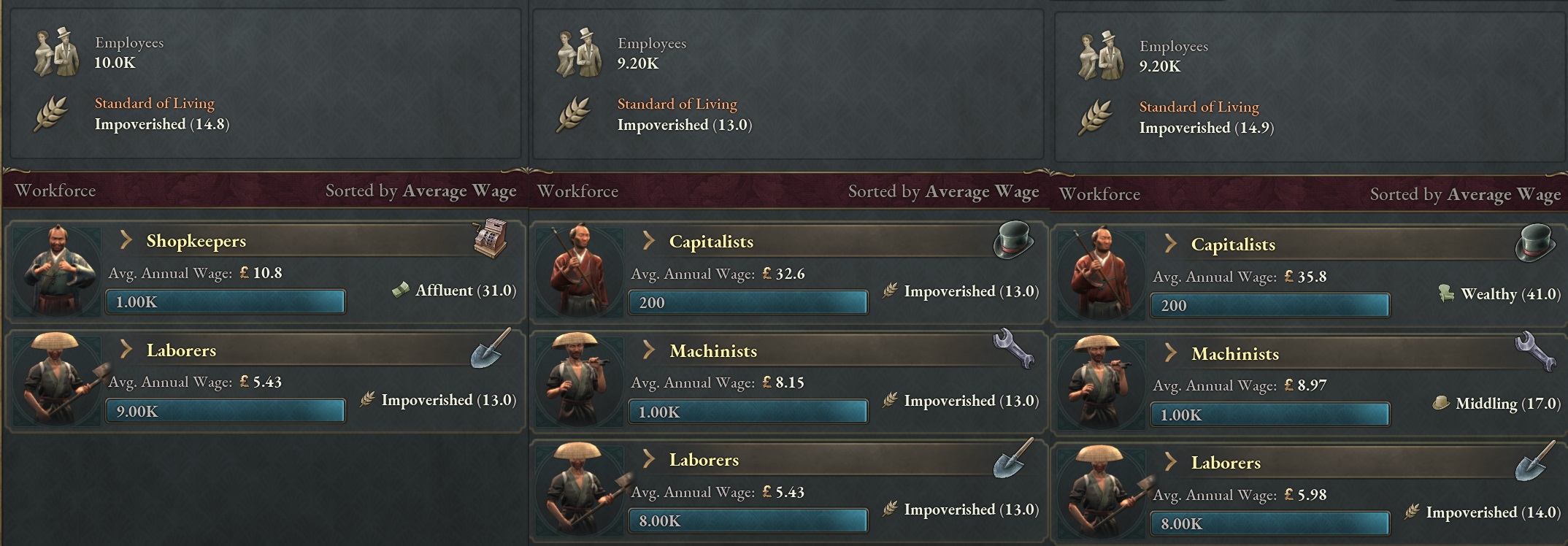
The change in lumber industry in Chubu. And a year after the change.
It was not all though. In January, the logging camps of Hokkaido saw the usefulness and also adopted sawmills.
By April 1837, all but the mills in Chugoku, the biggest ones on the island, were using tools. The difference is staggering. And the demand for tools was still high, even though the factory was running at full capacity.
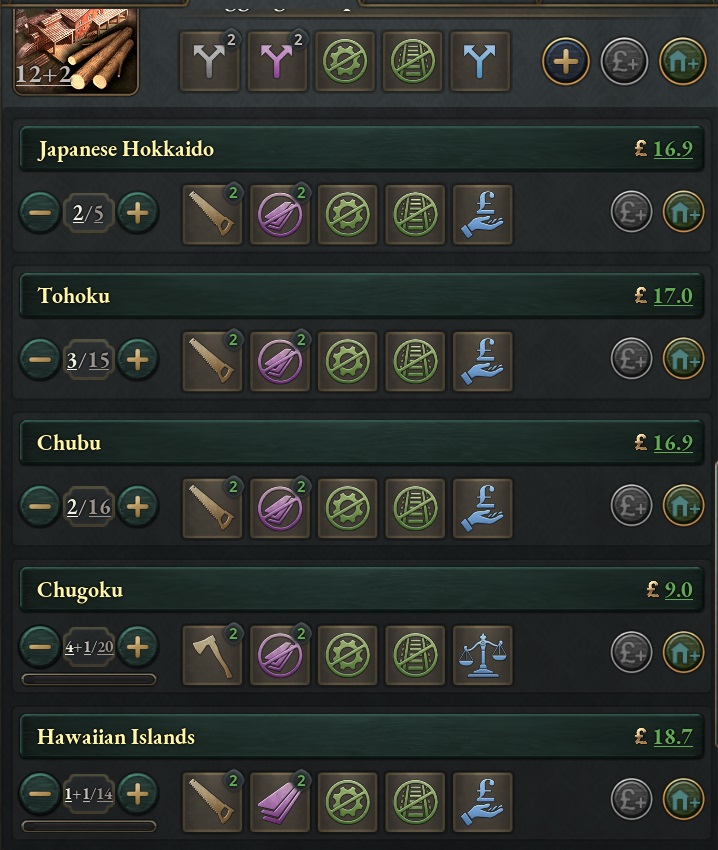
All the lumber industry of Japan. Notice the difference between Chugoku ones and the others
It was in May 1837, when a second tools factory was opened in Edo. Followed by Chugoku adopting tools in June. With this, every lumber mill in the Empire was using tools. Before the reforms, the Japanese logging industry amounted to around 300 lumber. After, it was near 800. Almost a triple increase. Of course, the only thing being that the demand had increased as well. Especially the construction sector that used to be 150 lumber now demanded 900.
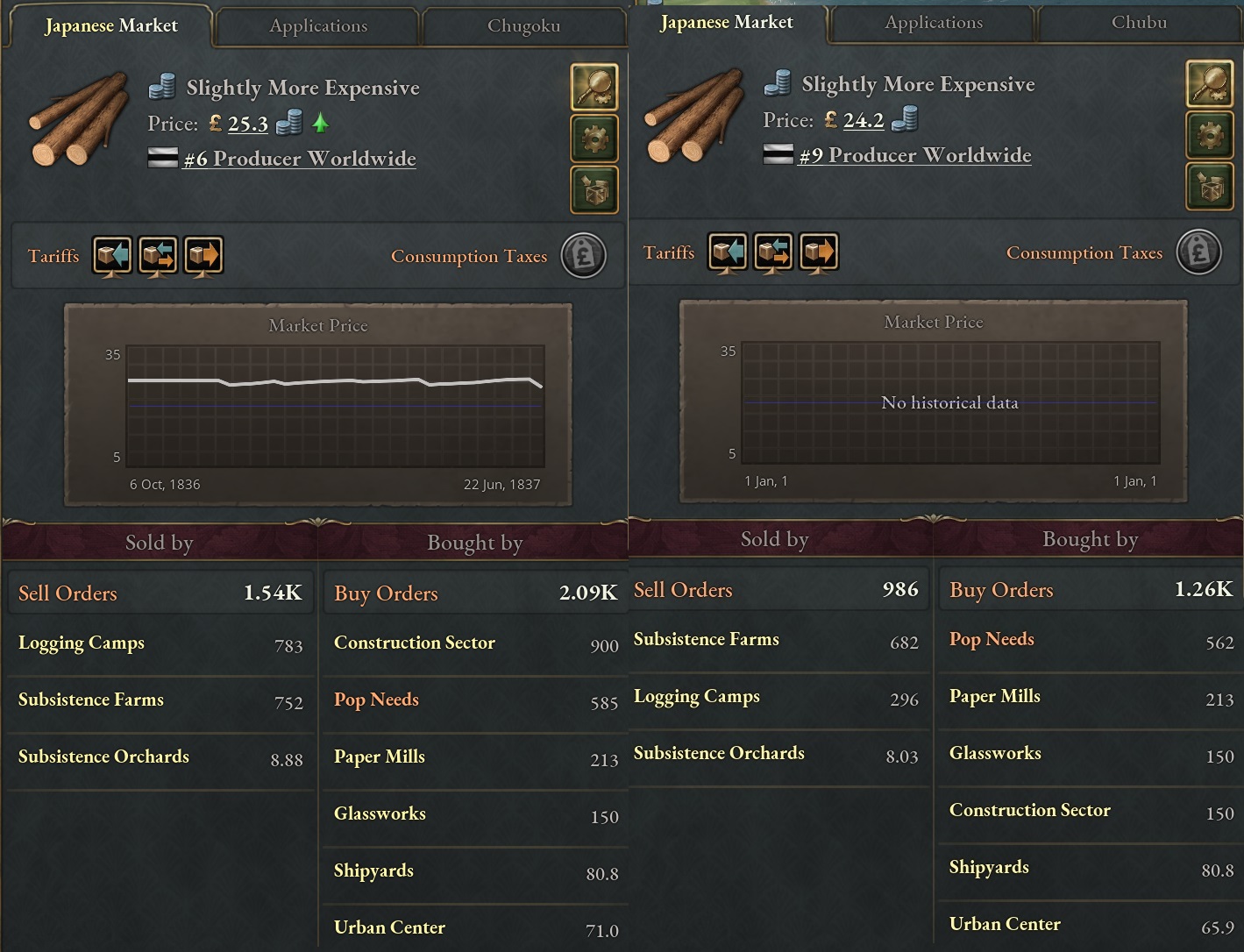
Lumber in the summer of 37, compared to January of 36
On other news: In April 1837, the Japanese discovered the usage of cotton gin. It was timely too, for the need for fabric had also risen when the construction sector had expanded at high speed.
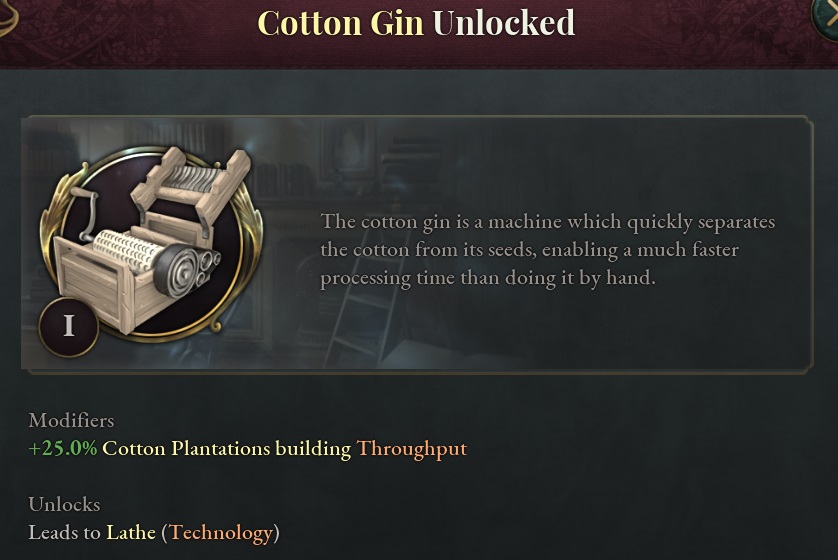
The first invention
Boots on Ground
Soon after the Japanese bluffed themselves to Sulu North Borneo, they turned their attention to the rest of the state. Namely, the Sultanate of Brunei, who held the rest of the state. And most of the freshly discovered gold fields in that state.
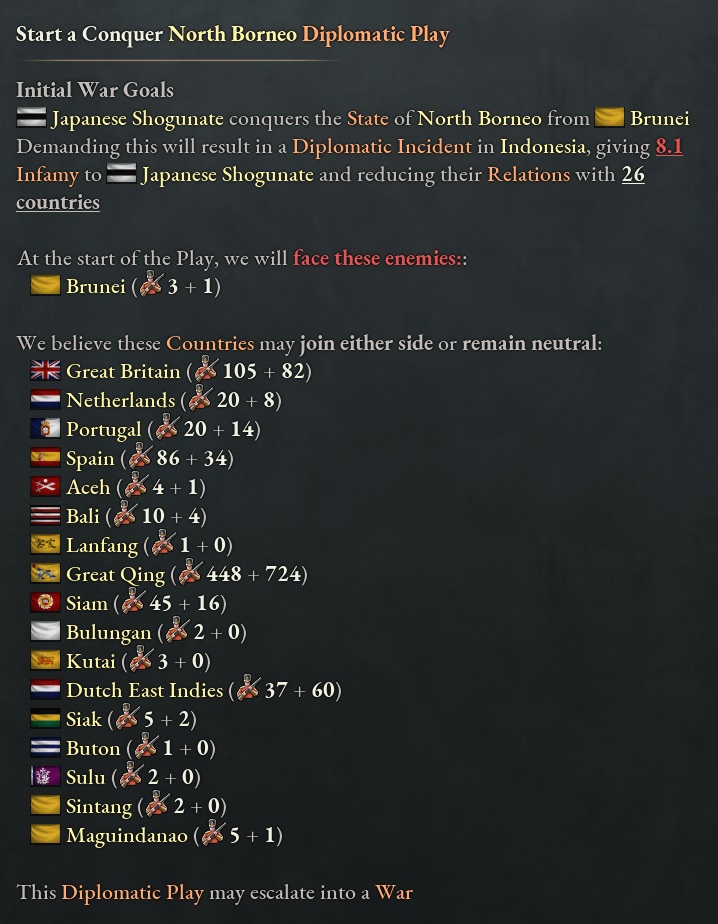
This time, we are not bluffing
This time, it was not a bluff. This was the first true external expansion of Japan. For the Shogun recruited a new general, Tamon Shinsaku. A warrior known for his bravery, loved by his soldiers and common folk alike. Gave him 15 000 soldiers and sent him to Borneo.
If you are doing a naval invasion, you need warships. Enough warships to fit the troops. Enough warships to cover the troops when they’re landing. But this is not a naval invasion, for Japan and Brunei actually have a common border. Thus, soldiers can be transported over by merchant ships, then, they form up and gather at the border. That is exactly what Shinsaku did.
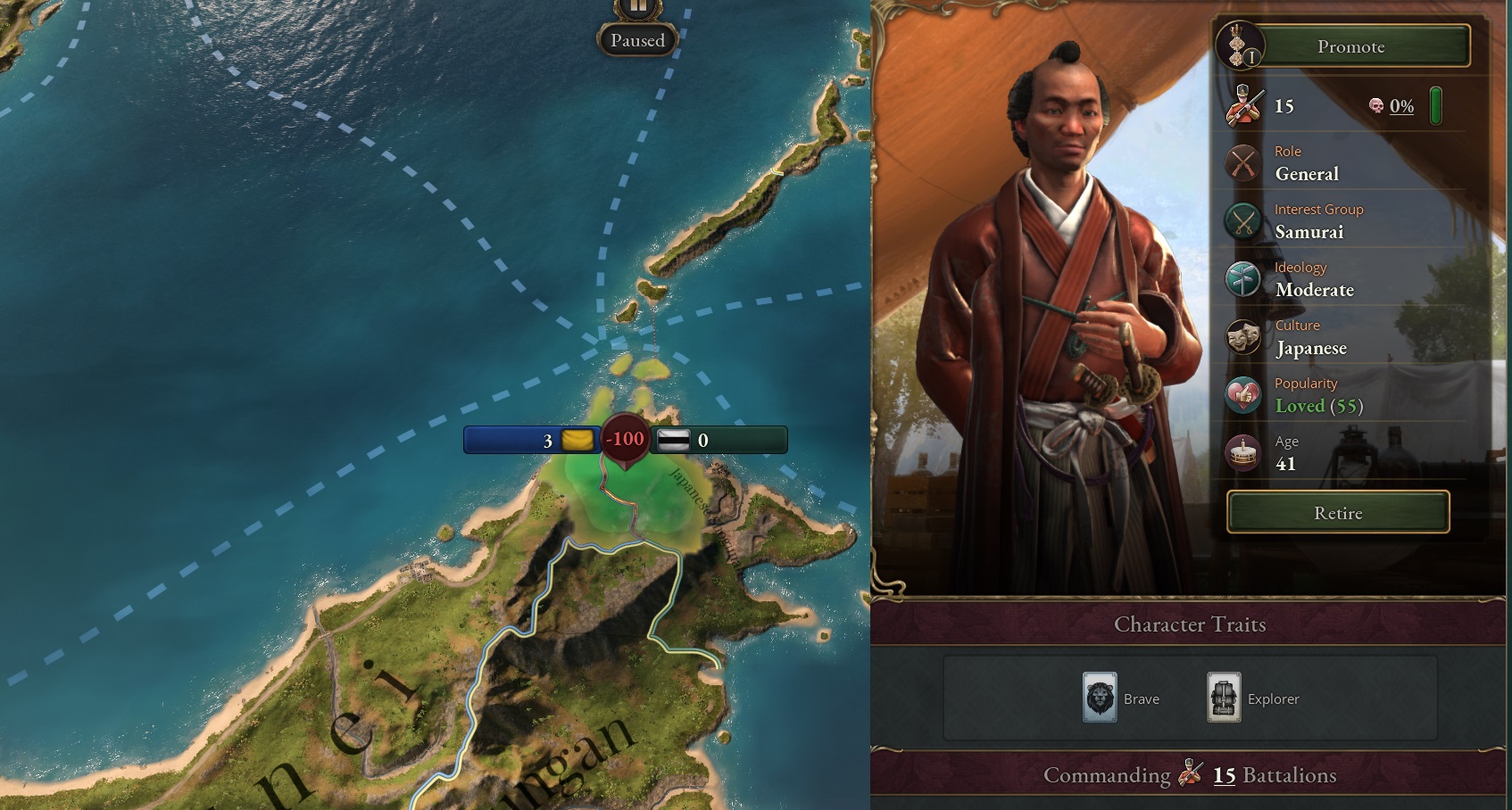
General Tamon Shinsaku, heading to the North Borenan front.
Borneo was able to field about tenth of the soldiers Shinsaku had amassed on their border. In addition, they were able to gain help of Siak in Sumatra and Maguindanao in South Philippines, but even with their combined power, they could not reach half of Japan’s forces.
Much to the disappointment of Japanese, who were actually awaiting their first real, true war, on 2nd January 1837, the Brunei Sultanate gave up, allowing itself to be swallowed by the Japanese Empire.
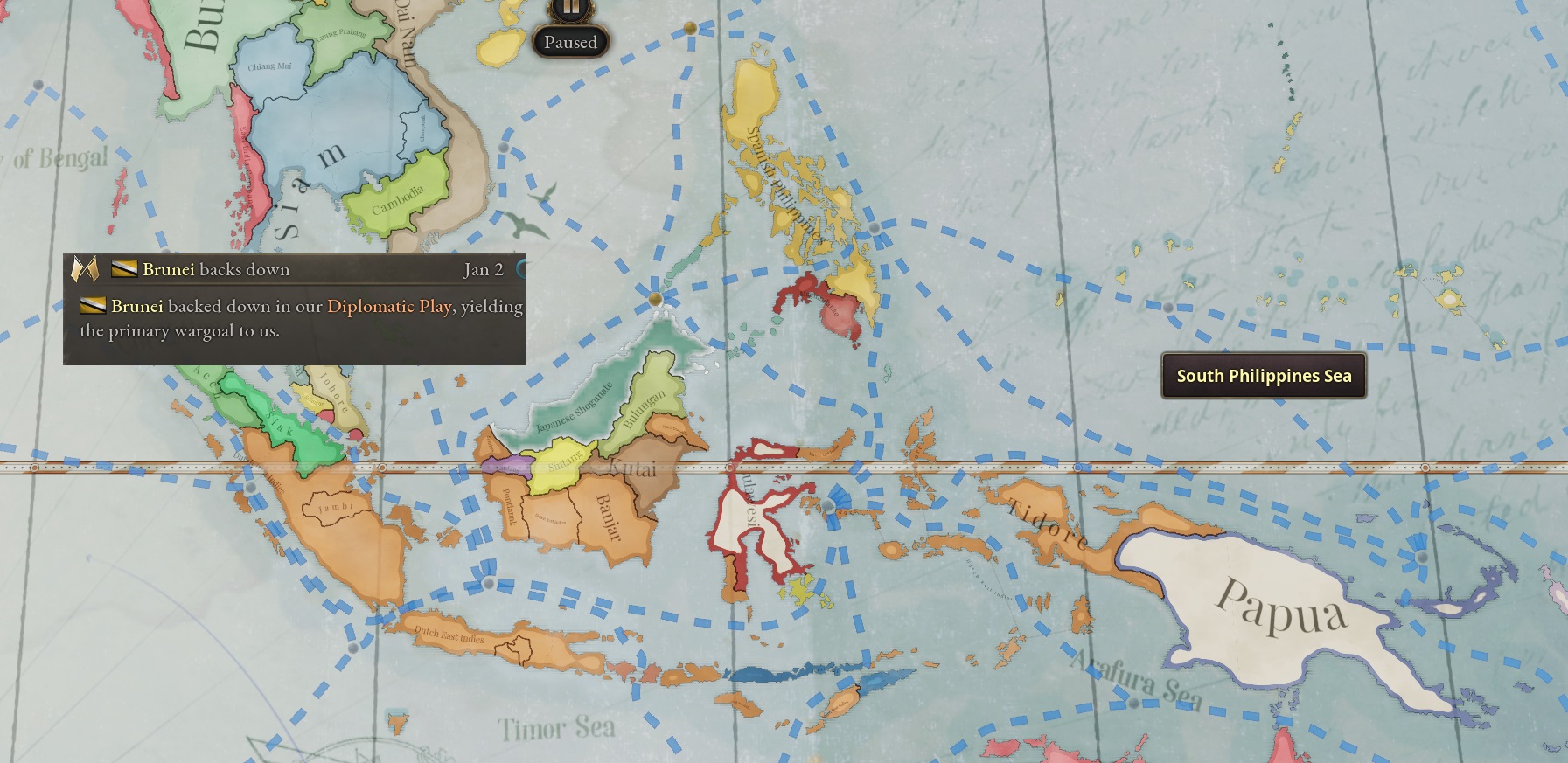
Again, no war.
Turned out that the main issue was that there was not enough people to properly fill the gold fields. By February, around 20 000 people were working there, but that was about that. Turmoil and the status of a newly conquered state most likely didn’t help much. Still, it was around 2000 pounds per week more for the Japanese than it had been.
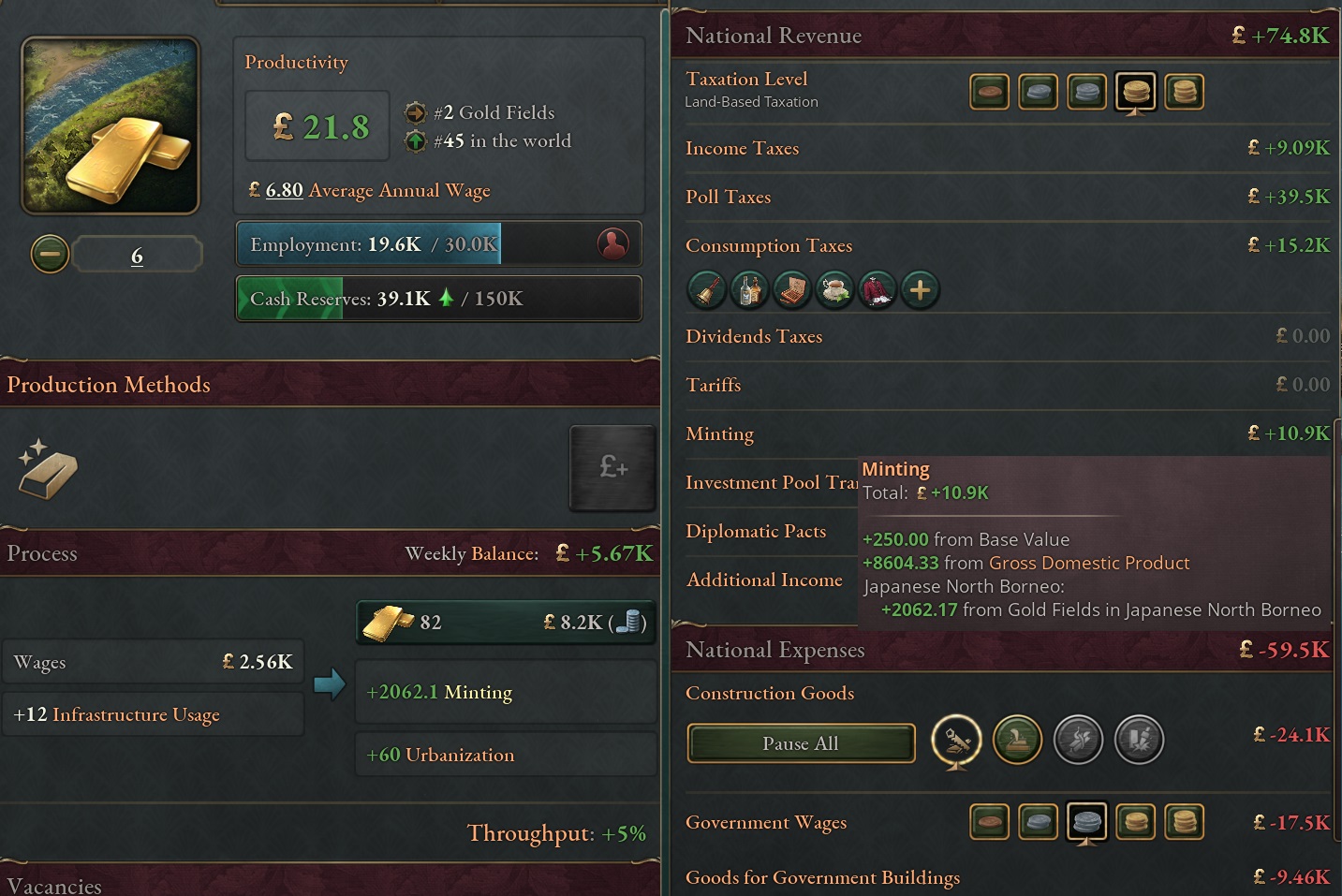
Gold, for now. Still, a nice boost to income.
For now though, Japan took a small break. To improve the relations with the Dutch, English and Dutch East Indies and let the emotions of sudden conquest cool off a bit.
- 3
Ok, the construction industry had expanded about 4 times, first tooling done, all lumbermills upgraded to sawmills. Now, to deal with the shortage of lumber, get more iron industry up, then try to move to iron-frame buildings for even more construction.
And since we actually shared a border with Brunei now, the Japanese no longer have to bluff, but can send actual soldiers to the front. They still give up though.
In all of honesty, this is a case of a single nation that does not have any naval capacity, but does have huge armies and no-one to conquer with them.
It is silly, but this is very Japan-specific silly, I imagine. On other cases, nations have some navy to invade, don't have armies to bluff anyone or have some nice neighbors to conquer so they don't have to bluff distant islands
And I shall get a navy up and running in a few years, so these were the last bluffs. I hope.
And since we actually shared a border with Brunei now, the Japanese no longer have to bluff, but can send actual soldiers to the front. They still give up though.
This seems... very rapid. Especially if there's no sealift capability to bring the army down to the front! That should be a definite -100% to enforcement capability of diplomatic plays from the primary mover. But what do I know.
In all of honesty, this is a case of a single nation that does not have any naval capacity, but does have huge armies and no-one to conquer with them.
It is silly, but this is very Japan-specific silly, I imagine. On other cases, nations have some navy to invade, don't have armies to bluff anyone or have some nice neighbors to conquer so they don't have to bluff distant islands
And I shall get a navy up and running in a few years, so these were the last bluffs. I hope.
- 1
The Land Question
The Land Question
“I can’t believe it was done! And so easily,” said Jin with a jubilant voice.
“Innkeeper, bring us your best sake,” he added. “This is a cause of jubilation.”
Though, to be fair, the best sake of the rundown teahouse tasted, well, a bit less piss then the usual one. Still, the two man raised their cups in celebration.
“The serfdom in Japan is abolished,” Jin continued. “The peasants are free! And it took just a bit more than a year and two tries!”
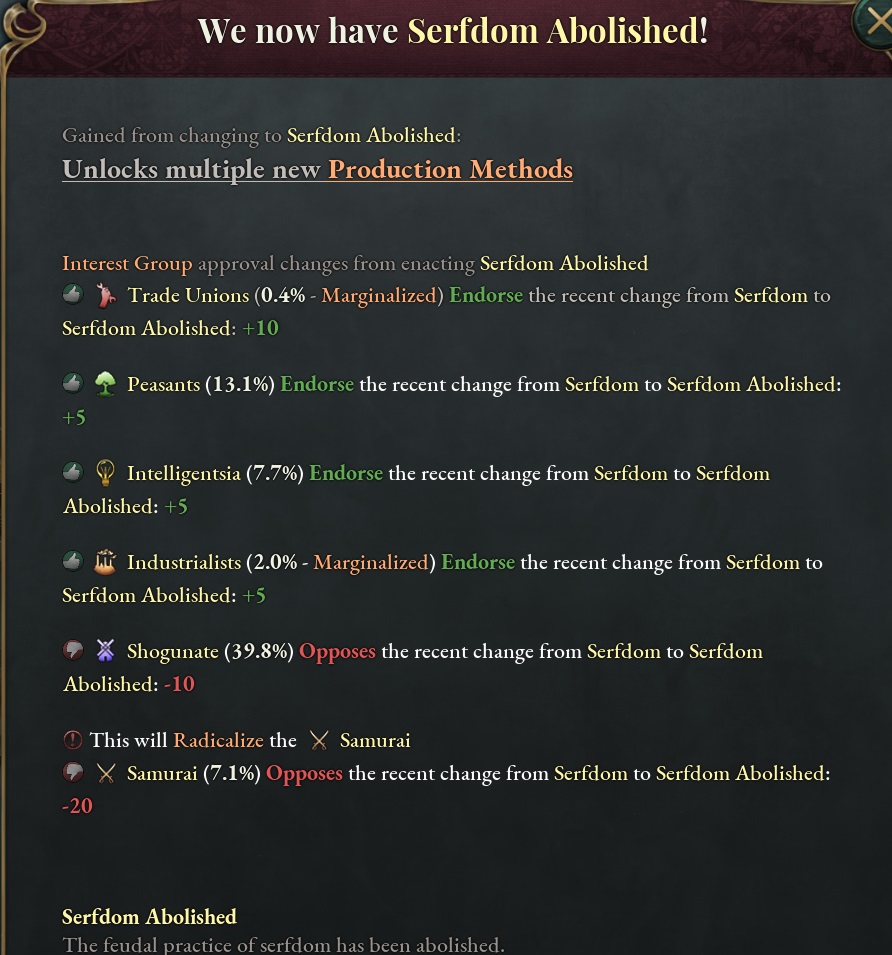
Bye-bye, serfdom!
He held his cup up high.
Yoshimichi did not look as elated though. “In a way, Jin, you are correct.”
“What do you mean, in a way! As of today, no noble can claim the peasant to be his!” said Jin, surprised.
“Ah, yes, you are absolutely correct. Just, what changed?”
“A lot! The power of the Shogunate diminished, the daimyos were taken down a notch, and the peasants are finally free!” Jin was still elated.
“The peasants are free to do what?”
“To keep on working in the fields, on their own behalf, free of the lords?” Jin asked
“Oh whose land?” Yoshimichi replied with a question.
“Oh,” said Jin. Elation left his face.
“The peasants are free, yes.” Yoshimichi continued. “They cannot be brought or sold like dogs. They cannot be forced to work on their masters fields no more. They are free to leave if they wish.”
“But all the land belongs to Shogunate, who gives it to daimyos, who give it to their vassals. The peasants don’t own any. Meaning that they need to rent the land from the landowner, with terms set by the landowner. This will most likely not involve right of the landowner to sell his peasants, but can still involve working on lords' fields, paying most of their harvest as rent and such.”
“So, nothing changed?” Jin looked truly shocked. “Nothing at all?”
“If you happen to be daimyo, then in your eyes, pretty much nothing, yes.” Yoshimichi looked sly again. “That is why the law was passed so easily, I think. Not too much opposition on that one, actually.”
“But you are getting that sly look in your face again?” asked Jin. “I imagine this has some consequences the daimyos could not predict?”
“Where is a peasant to go if he is unsatisfied with his lord?” asked Yoshimichi in return.
“Well, as of yesterday, nowhere,” Jin pondered. “As of today, I guess, to another lord?”
“Or to the city,” said Yoshimichi, triumphantly. “To work in one of my factories, be it a simple laborer or machinist or something. Or to perhaps open a shop in the growing urban center? Or even work as a street-sweeper.”
“So, in a way, you made peasants free, so you can have a labor pool to draw from?” Jin’s eyes were wide of surprise.
“In a way, yes.” Yoshimichi was having this sly look again. “Peasant can’t decide to come to work in the factory if he is a property of the lord.”
“But, this is a bit more. This creates a shortage of peasants. Creating an incentive for the landowners not to bleed their peasants dry, for a landowner without his peasants is a nice person who owns a lot of land that lie fallow, because he has no-one to till them.”
“So, by getting richer, you are also making the peasants' lives easier?” Jin said with disbelief.
“Believe it or not, that is so. And sooner or later, some landowner short on cash comes up with a brilliant scheme- selling the land to peasants can net you cash right here and now. Making the peasant his own landowner and making him actually lose a lot in the long term. And others will follow suit, for everyone has a situation where they need cash here and now,” Yoshimichi grinned.
“Making the peasant a landowner in the long term?” asked Jin
“And making the daimyos and the shogunate lose in the long term, yes.”
“So, what happened today is just a foundation?”
Yoshimichi nodded. Then, raised his glass. “To foundations, Jin.”
“What next for us?”
“I think Ienari would love to see one thing changed. No longer do government positions pass from father to son, but instead, he gets to pick and choose the fillers of positions.”
“This would make Ienari happy, Jin agreed. “Is it good for us as well though?”
“The Shogunate is not known for her ability to collect taxes, meaning less money for construction. It is good for us as well, believe me”
“Just, the inherited bureaucrats are not happy?”

Less power for Shougunate, more taxes to Shogun. A logical decision.
Yoshimichi nodded.
“Anything else interesting?” Jin inquired.
“In the end of September, the first iron mine near Edo was completed,” replied Yoshimichi. “As a result, we changed the production methods of our tooling shops to pig iron. This, of course, created a huge shortage of iron right away. Still, this is another capitalist-run venture now and in time, if iron shortages are ironed out, will produce a lot more.”
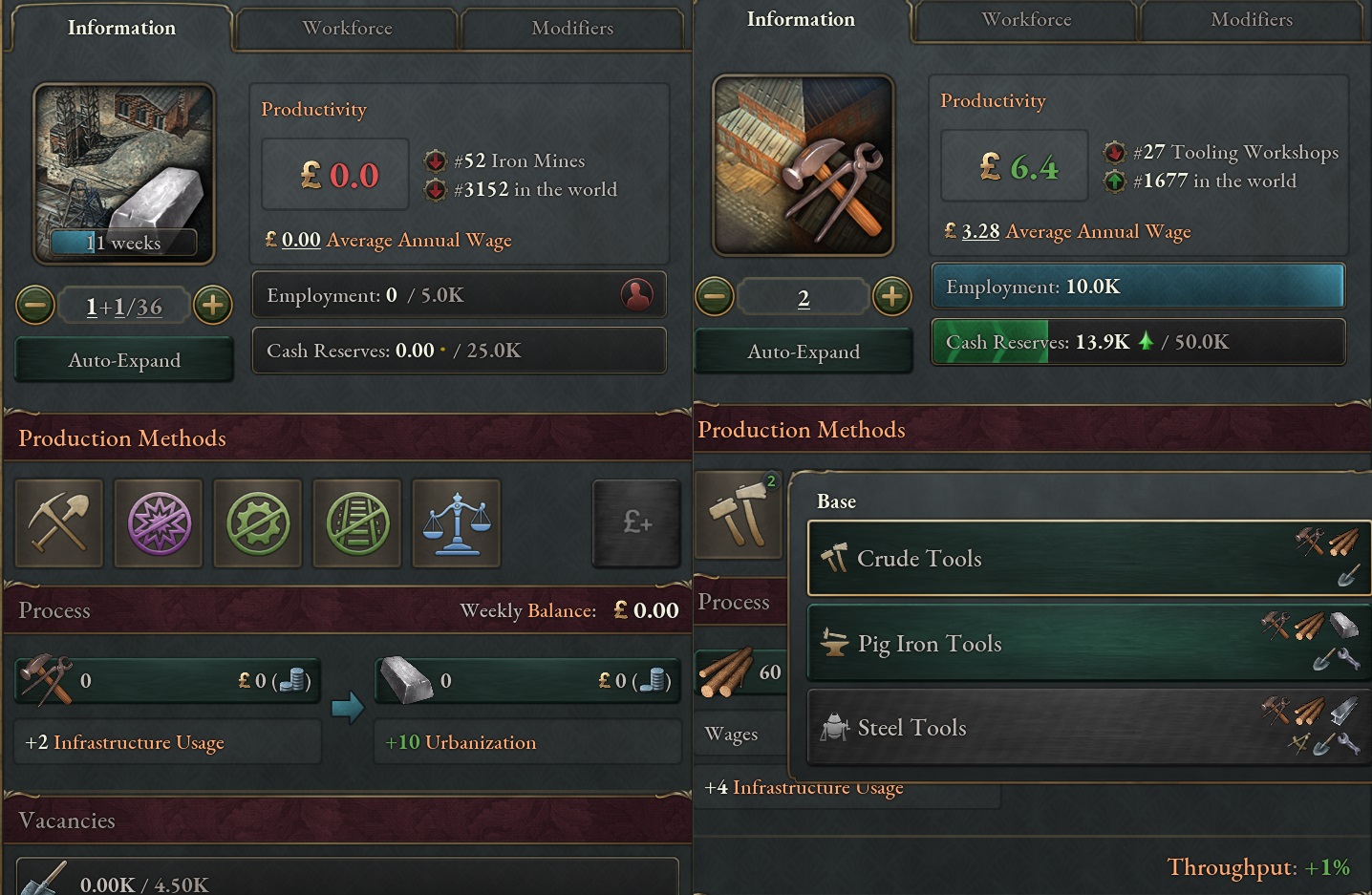
First iron mine and conversion to pig iron tools.
“That’s that then?” asked Jin.
Yoshimichi nodded.
“Until next time,” Jin winked, stood up and left the shoddy teahouse.
It was the 10th of November 1837. The Shogunate had abolished serfdom.
- 2
Glad to see that this AAR is now in official Vicky 3 AAR forum. Thanks to whoever moved it!
Also, this episode is kind of a rant on my part. Ownership of land was quite an important question on 19th century and even at beginning of 20th century. Serfdom ending did not magically empower peasants, cause ending the serfdom usually did not come with land, forcing the peasants to stay with their lords on pretty much the same terms.
I personally think the ownership of land should be represented a bit better. And unless there was a revolution, it should be a gradual change.
Also, having serfdom in effect should hinder your industrialization efforts, at least to a degree. For kinda hard for a peasant to come looking for a better life in your new factory when his owner doesn't want him to go.
Anyway, that's that. Sorry for the rant.
Until a western power decides they don't really like me much at least
Also, this episode is kind of a rant on my part. Ownership of land was quite an important question on 19th century and even at beginning of 20th century. Serfdom ending did not magically empower peasants, cause ending the serfdom usually did not come with land, forcing the peasants to stay with their lords on pretty much the same terms.
I personally think the ownership of land should be represented a bit better. And unless there was a revolution, it should be a gradual change.
Also, having serfdom in effect should hinder your industrialization efforts, at least to a degree. For kinda hard for a peasant to come looking for a better life in your new factory when his owner doesn't want him to go.
Anyway, that's that. Sorry for the rant.
Great success! Can it be continued unabated?
Until a western power decides they don't really like me much at least
- 1
Lucky you, no one has moved mine yet, despite me pinging Qorten on Friday.Glad to see that this AAR is now in official Vicky 3 AAR forum. Thanks to whoever moved it!
As for the update, an important step indeed!
- 1
See, reading this as my political scientist self, I get bothered by the assignment of the "radicalization" label for the aristocracy. I feel like there should be an ever-present struggle between the radicals and reactionaries (think of the power slide in HoI4 with the Italy update) where going too far down either path would lead to the crack down or revolution. Seems like that would be a better representation than all groups being lumped together as "radicals."
First Blood
First Blood
Red Hot Iron, White Hot Iron
“The journey was uneventful,” the old man started. “Indeed, as promised, they got us to Amsterdam from Batavia with little over 100 days. We spent it wisely though. We hired a Dutch from Batavia who, in return of voyage to Amsterdam and some extra coins, promised to teach us English.”
“How did it go?” the younger man asked
“Well, in England, it turned out that indeed, we were all speaking very fluent German,” the older man chuckled.
“But you know, I thought Batavia to impressive. But Amsterdam was even more impressive. And from there, it was just a short voyage to London- and believe me, that was even more impressive.”
“I know, I’ve been,” replied the younger man.
“But you could not see the same contrast as I,” said the older man. “Coming from mostly rural Japan to the most industrialized nation in the world, where riches from all over the world gather to. The lavish life of the upper class- and the extreme poverty of the lower class in contrast: From bright lights to soot-covered housing. From clean, well-dressed people to people in dirty rags. It was a city of contrasts.”
“Still is,” the younger man confirmed.
“But what really got me was the City of York. We were given a tour of the heart of Brittish metalworking there...” the older continued.
“First, getting there... we were taken by a train. We did not even know that such a thing existed. We must have looked like uneducated barbarians to our guides.” the old man chuckled at the memory.
“Still, a train. A steel beast, with carriages. No horses. Smoke coming from chimney. And it moved with a breakneck speed of 40 kilometers per hour. I was both terrified and excited at the same time, watching the landscape go past.”
“That slow?” younger man wondered.
“To you, perhaps. To me, it was fastest thing by far I’ve been on,” the older replied. “The distance between London and York is about 350 kilometers- and the train managed to do it with about 9 hours! It was amazingly fast! Imagine, it was only 100 kilometers less then distance between Edo and Kyoto and for us, it was at least a weeks journey.”
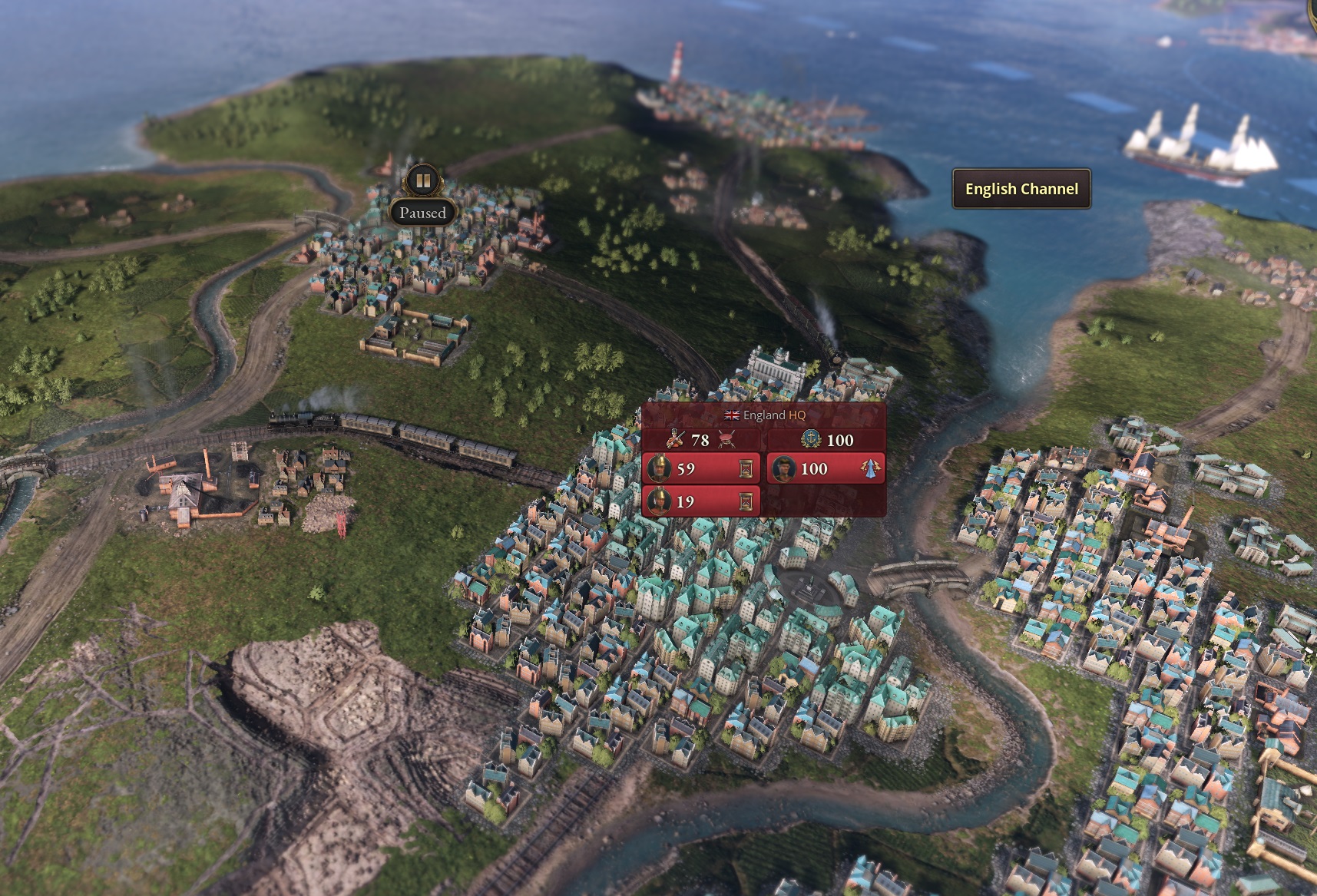
Departing from London
“The landscape started changing. When we entered Midlands, there were more and more mines, both of iron and coal. Even more so when we entered Yorkshite- it was one of major sources or iron and coal in England.”
“Nothing prepared me what I could expect in York though. Tall chimneys all over the city, with thick smoke emerging, darkening the skies. The blackend smoke, the dirty faces of humans. And the red hot iron of the great smelteries, where coal and iron was used to create steel in quantities and quality we thought impossible. Or the fine, sturdy steel tools produced there. Or the great engines. York was the heart of English metalworks, and it showed.”
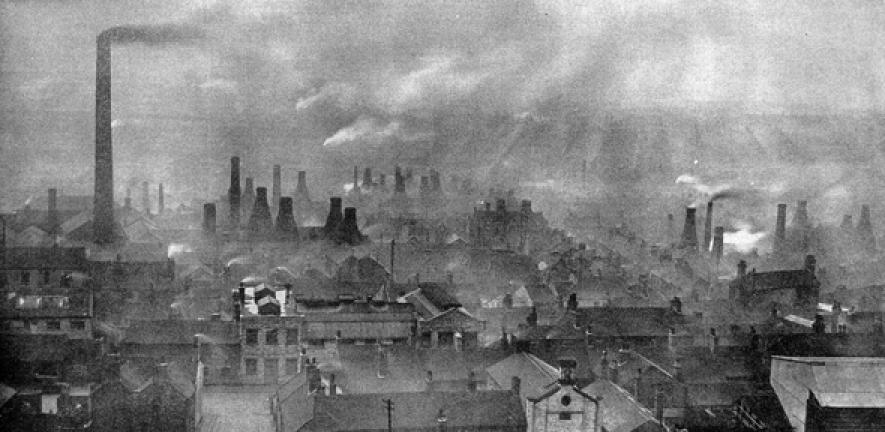
Not the most pleasant place to live
“My father looked at the city, and with an expression that was mix between disgust and amazement, said to me: “Son, remember. It is not the fancy gaslights of London that is the basis of British power. This place is.”” the older man continued.
“And with this, came understanding that unless Japan has these ugly, soot-covered cities, where the smoke of factories darkens the skies, we would never be able to catch up. It is the red hot iron, it is the white hot iron that makes the country.”
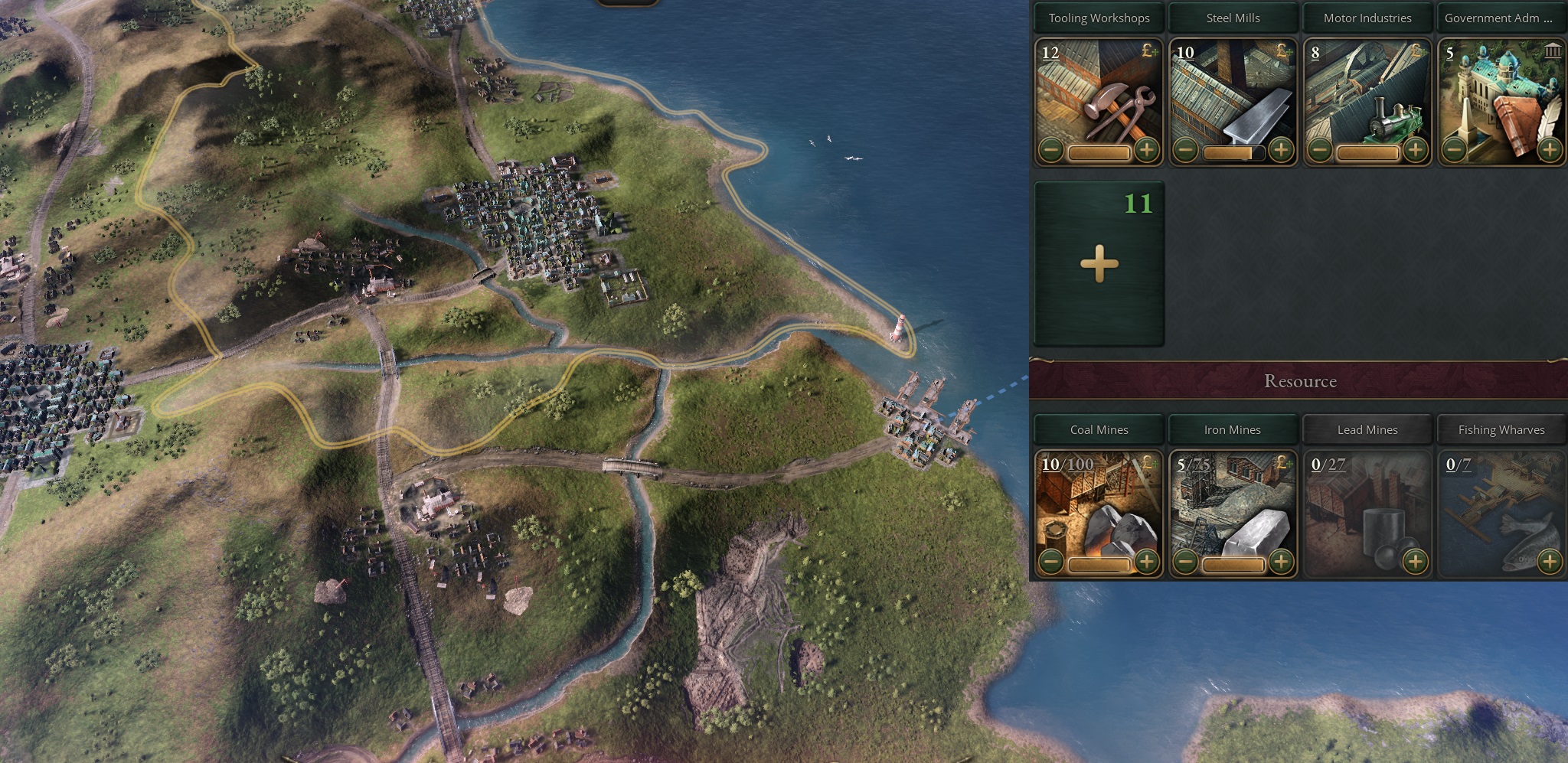
Yorkshire, a heart of British metalworking
Tooling Up
Japanese foray into Borneo had brought them to closer contact with the Western powers. And while it was obvious that the Japanese were more then a match to local powers there, it was also most obvious that against a moden western army, especially against the Brits, the Japanese forces in their current stance had no chance. In order to rectify that, the first move was to equip Japanese armies with artillery. That, of course, needed cannons. So, the first step was ordering of construction of arms factory in Tokoku in May 1838. It would take about a year to complete though.
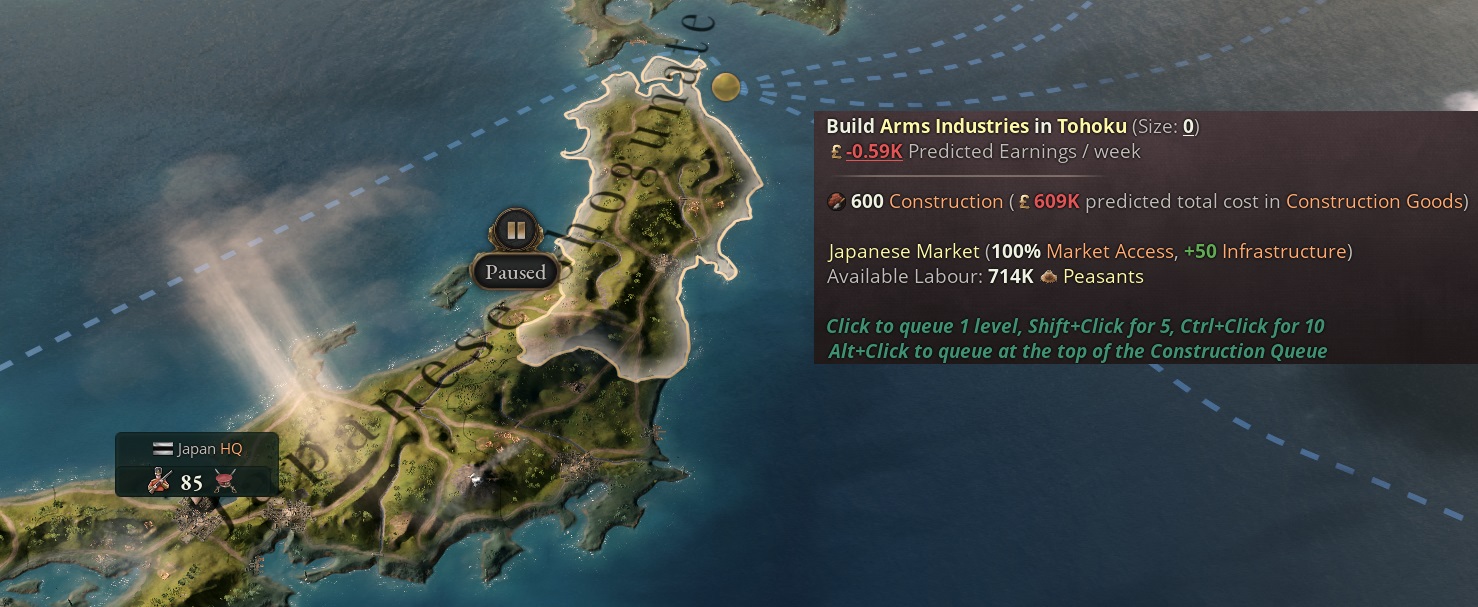
First arms factory being built in Tohoku
In June 1838, Ienari Tokugawa himself intervened in the process of getting hereditary bureaucrats replaced with ones appointed by him. “Get it done,” were his words. Strangely enough, while it increased the chances of this happening, the intellectuals did not like the fact that the shogun used his god-given right to interfere and were a bit unhappier. Still, with official support of the Shogun, there was pretty good chance of implementing this.
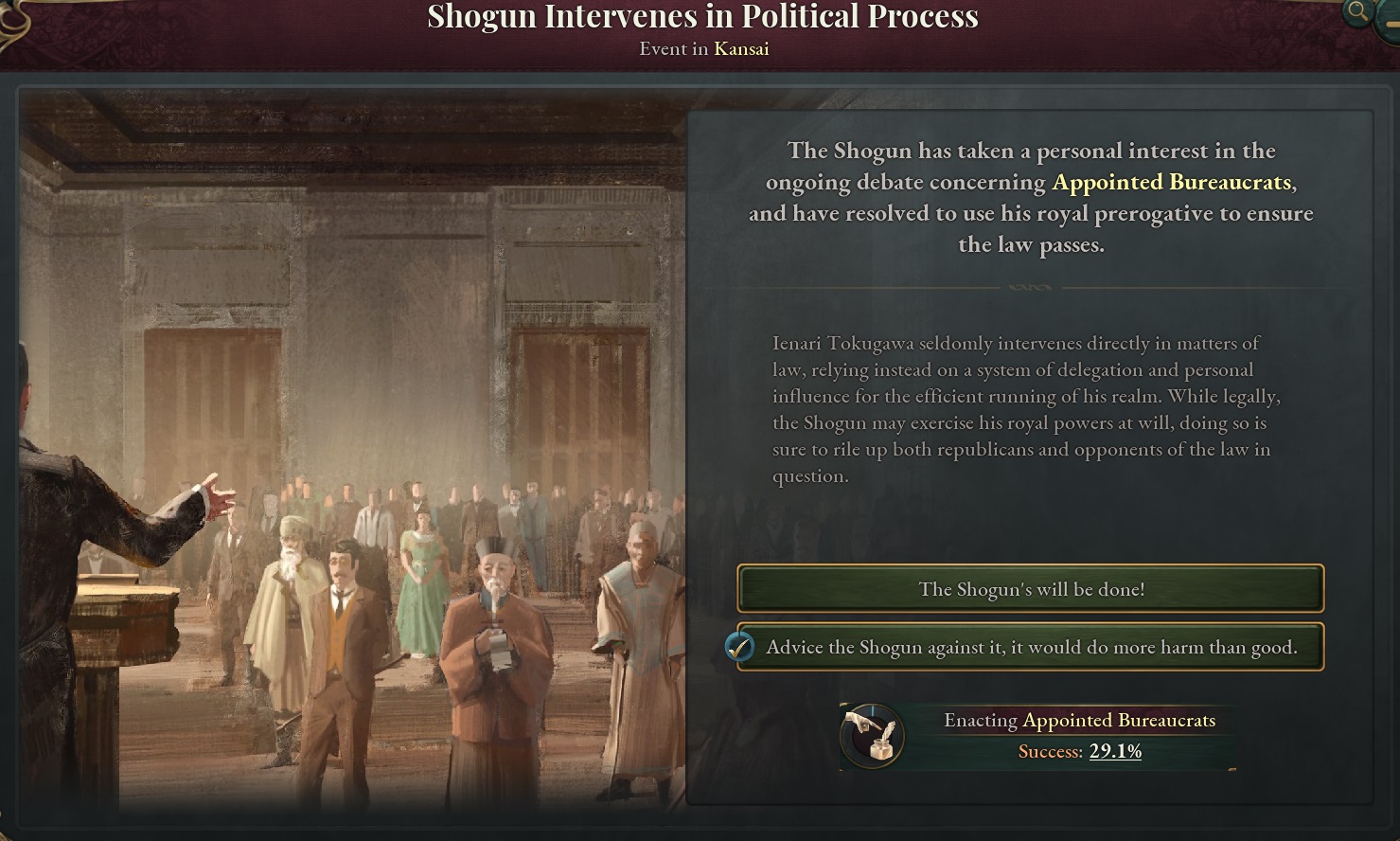
Tokugawa Ienari totally endorsing the appointed bureaucracy.
In August 1838, the Japanese discovered lathes. It was actually quite a simple mechanical tool, but it revolutionized most of the industries in the country.
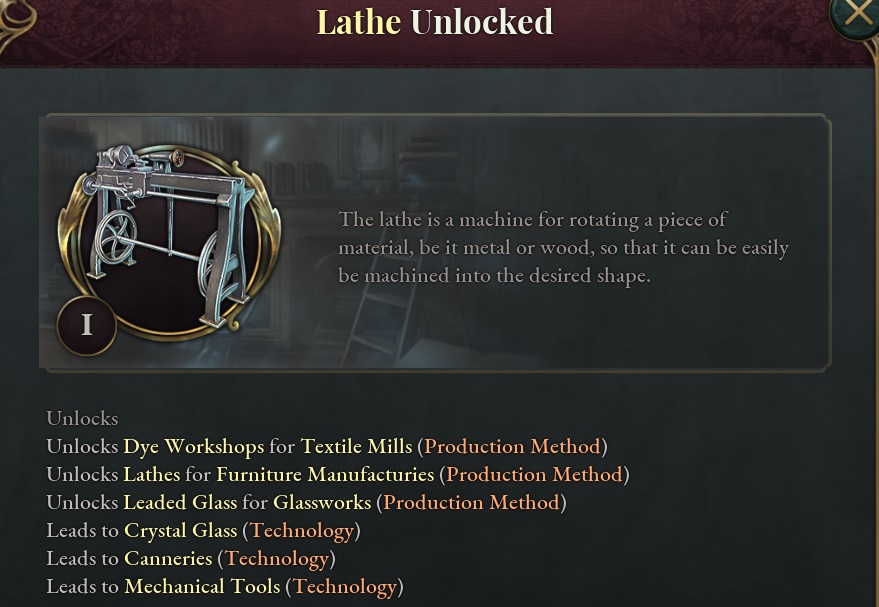
Let the industrial revolution begin!
The best example were the furniture manufactories in Chubu. With the implementation of lathes, the industry changed completely. From totally handcrafted furniture to mechanized- the production became more efficient, sure. It also changed how the production worked. From simple model involving the shopkeepers and laborers, it changed to much more complex system, with capitalists in charge, machinists working the machinery and for the first time in Japan, engineers.
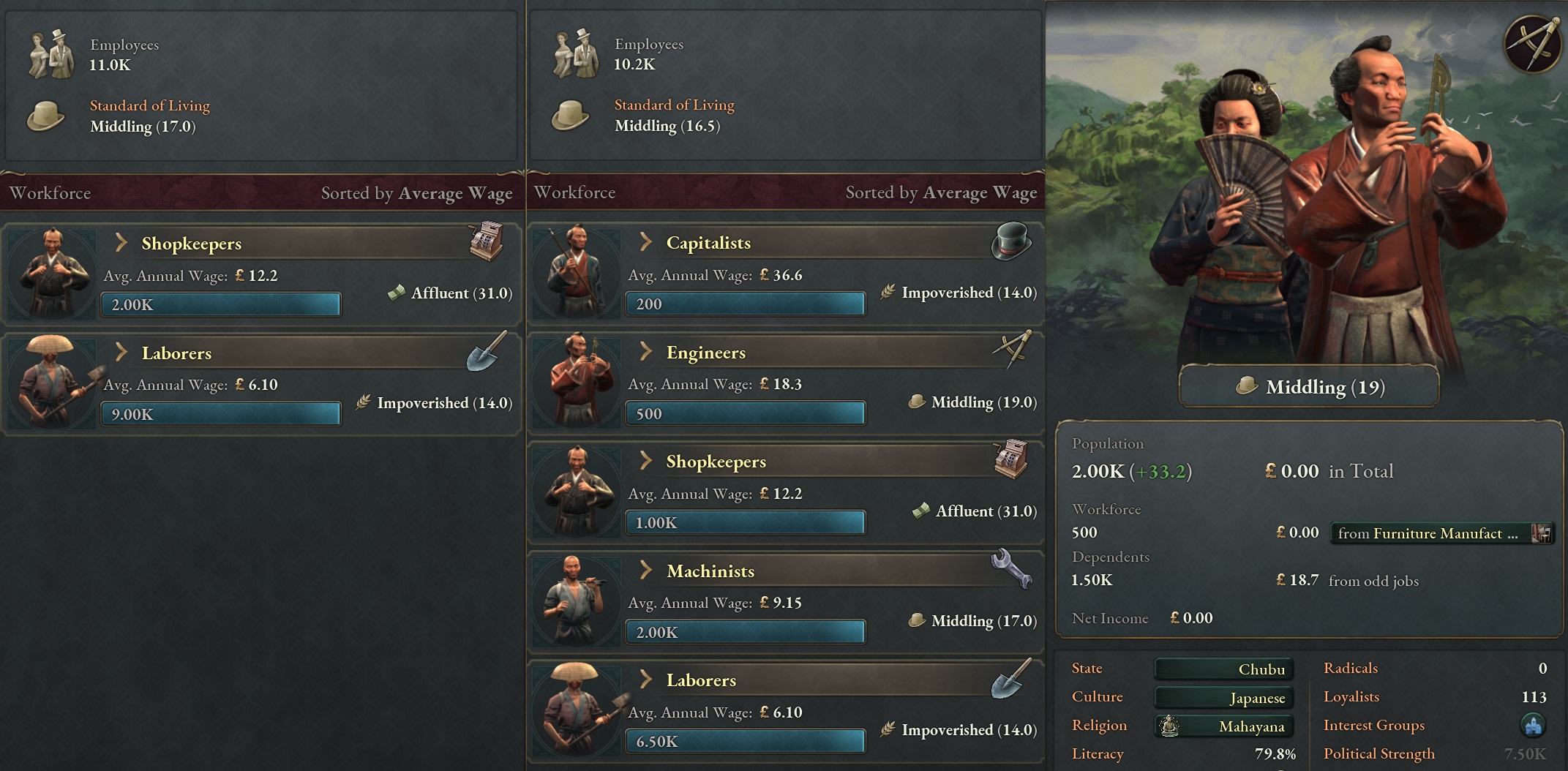
Furniture factory retooling. And a new class. Meet the engineers.
The clothes manufactories in Kansai and Kyushu also changed their production, becoming more efficient and creating the first true capitalists in the clothing industry in progress.
Followed by first Japanese lead mine being opened in Chugoku in September, and then first glassworks in the same state being converted from traditional forest glass manufactory to leaded glass. The industrial revolution of Japan was slowly on it’s way.
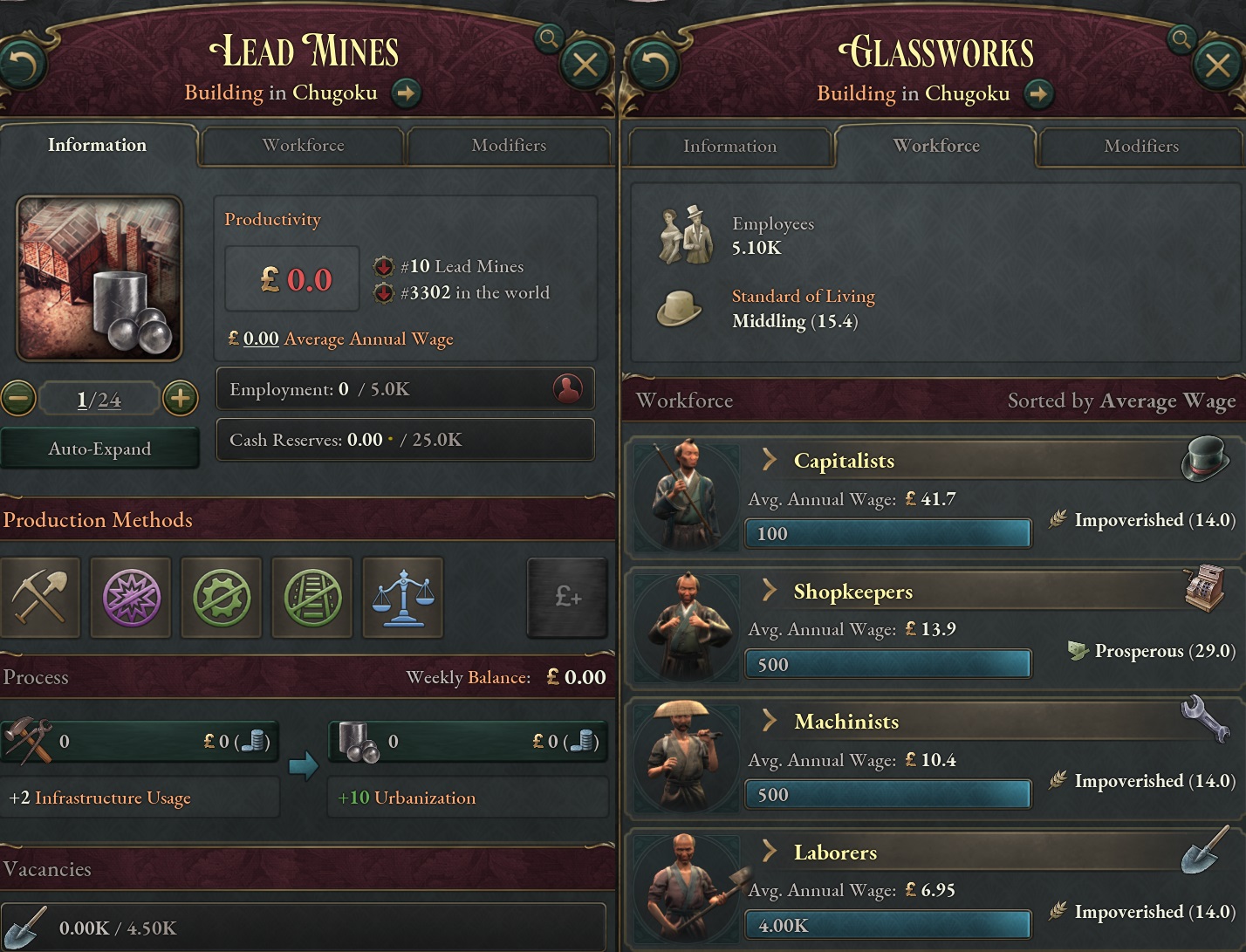
With the first lead mine, the production of glassworks changed to leaded glass
In November, followed by another iron mine in Kansai, a single construction office in Tohoku was converted to new construction method- iron-framed buildings. Making the construction more efficient, but also demanding more iron and more tools. The demand of iron was such that despite it showing great success in both construction capacity and sturdiness of the buildings, at the moment, Japan could not afford more.
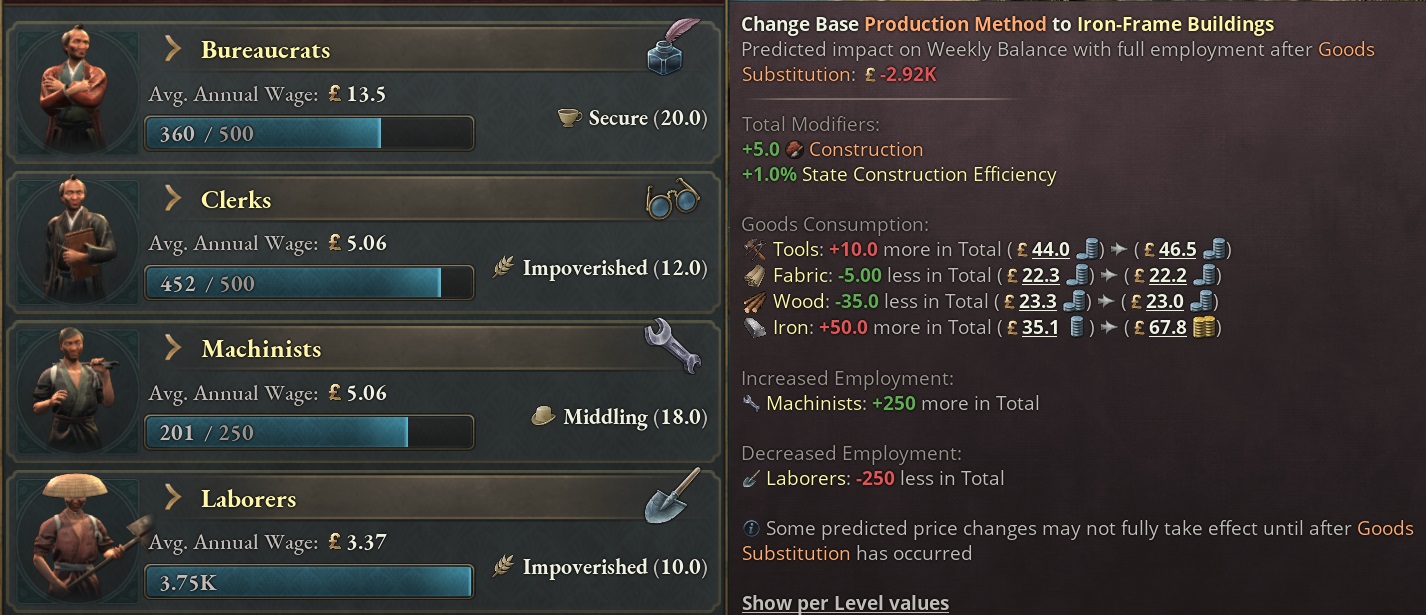
First Iron-framed buildings. Iron is still in short supply to make it happen for rest of Japan though.
Oshio Heihachiro, the head of Buddhist Monks in Japan, was caught with his pants down in December. The scandal of an esteemed monks being, well, just a pervert, shook the nation. A little. Oshio was still loved by everyone, contributing to the popularity of the monks. Just, a little less loved.
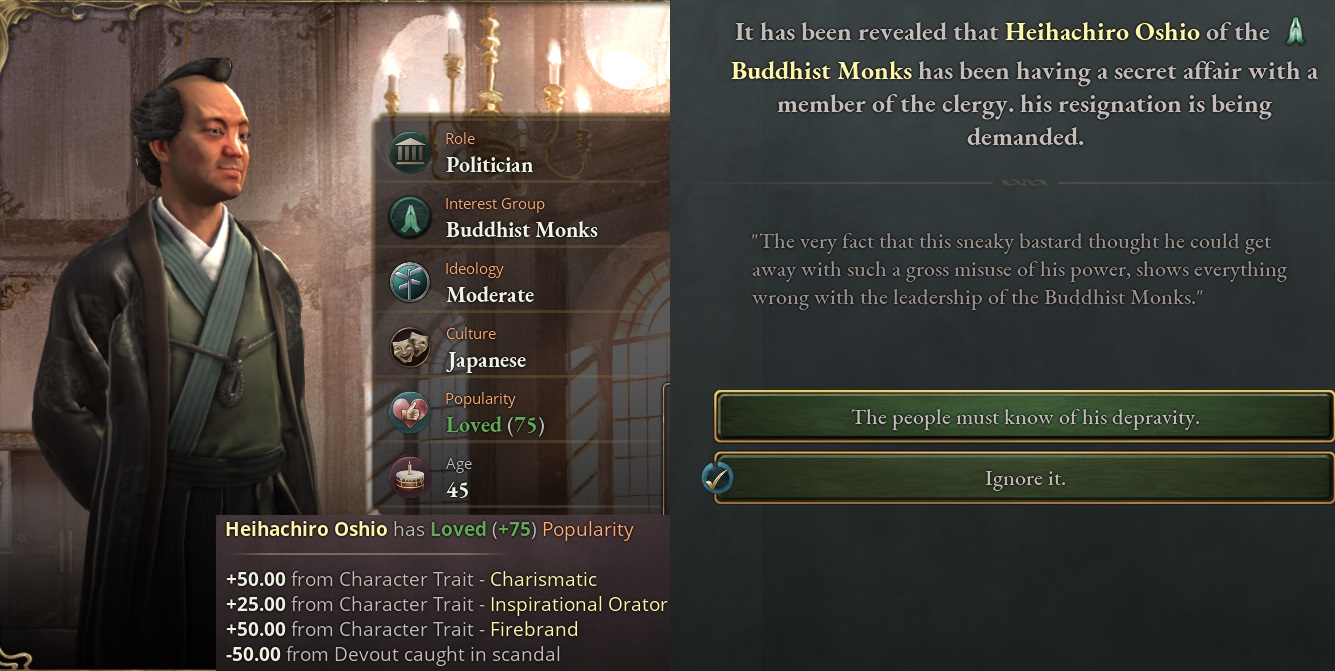
Still loved
First Blood
Bulungan was yet another small country in the Island of Borneo, consisting a few provinces in North Borneo and majority of her power in East Borneo. A logical next target for the Japanese, and thus, in March 1838, the Shougunate started their expansion there. As usual for the small states on the island, it was weak, able to field a few thousand men. A walk in the park, as the Japanese thought.
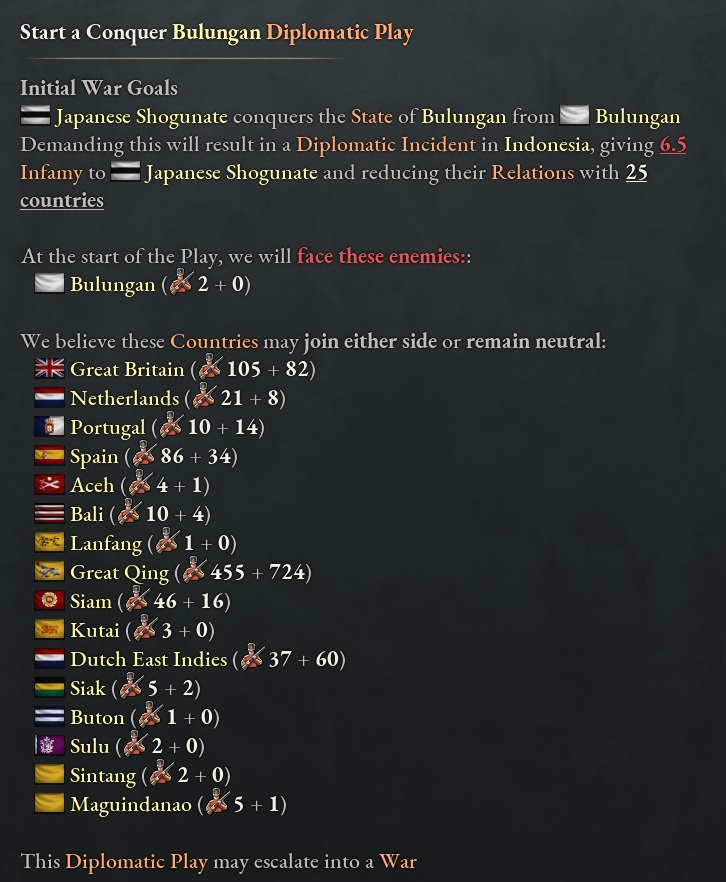
Picking on the weak again.
Again, Tamon Shinsaku was mobilised. Now commanding 20 troops, the general was marching at Japanese-Bulunganese border, hoping to scare the small sultanate into submission.
Not this time though. Instead of doing the reasonable thing and backing down, Sultan Muhammed Almuddin of Bulungan sought allies. And it seemed like the Japanese expansion on the island had irked the ire of the Dutch East Indies. So, in return for a simple obligation, the Dutch declared in April that they will support Bulungan.
This caused a bit of panic in Japan, for for the first time, there was a threat to meet the advanced European power in battle. But after assessing things for a while, the Japanese did not see any Dutch forces amassing in the border. So, instead of backing down, the Shogunate went ahead.
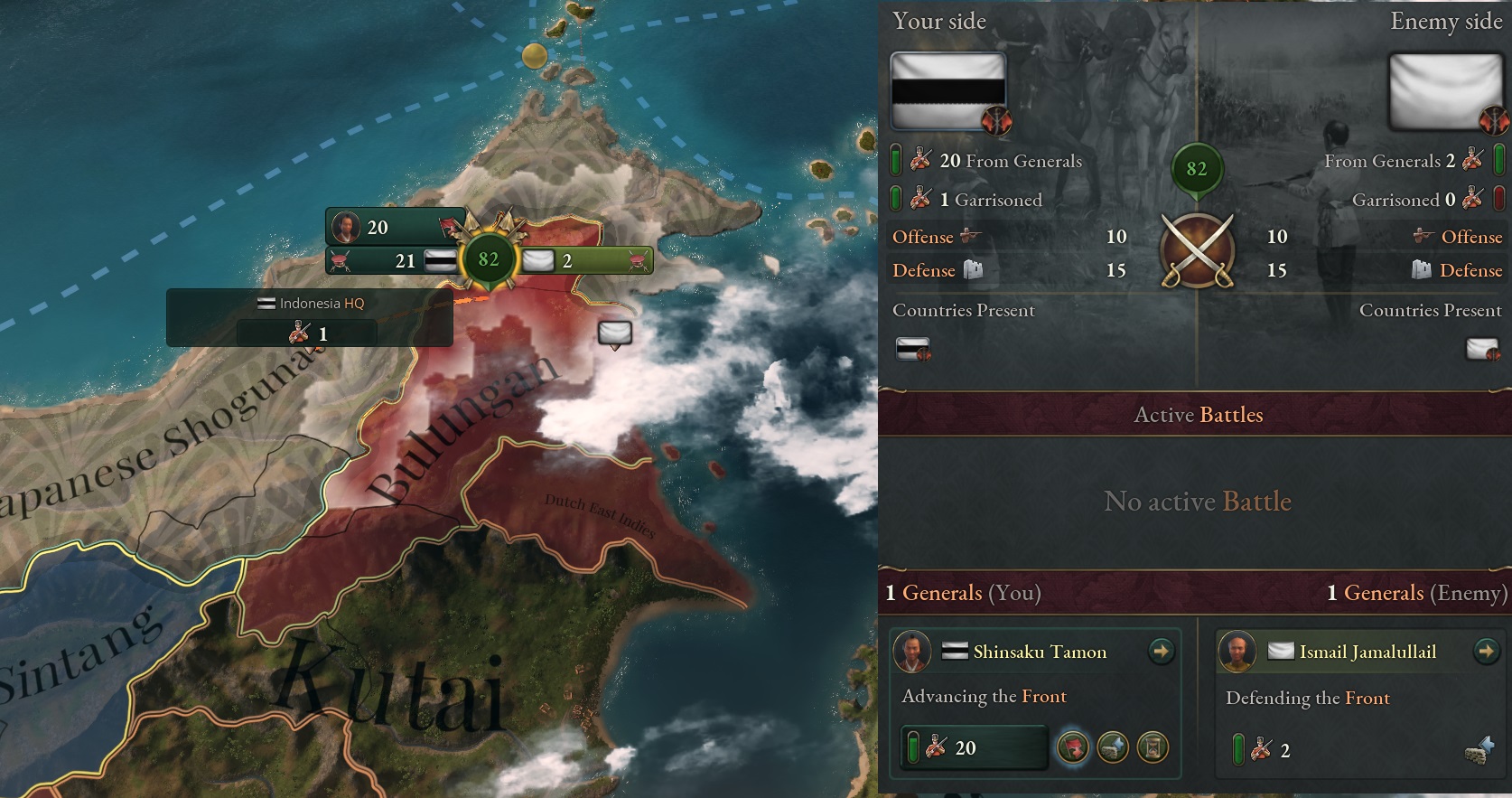
Not a Dutch in sight
On 19th of June 1838, the Japanese Empire started their first war in two centuries. Japan versus Bulungan and Dutch East India.
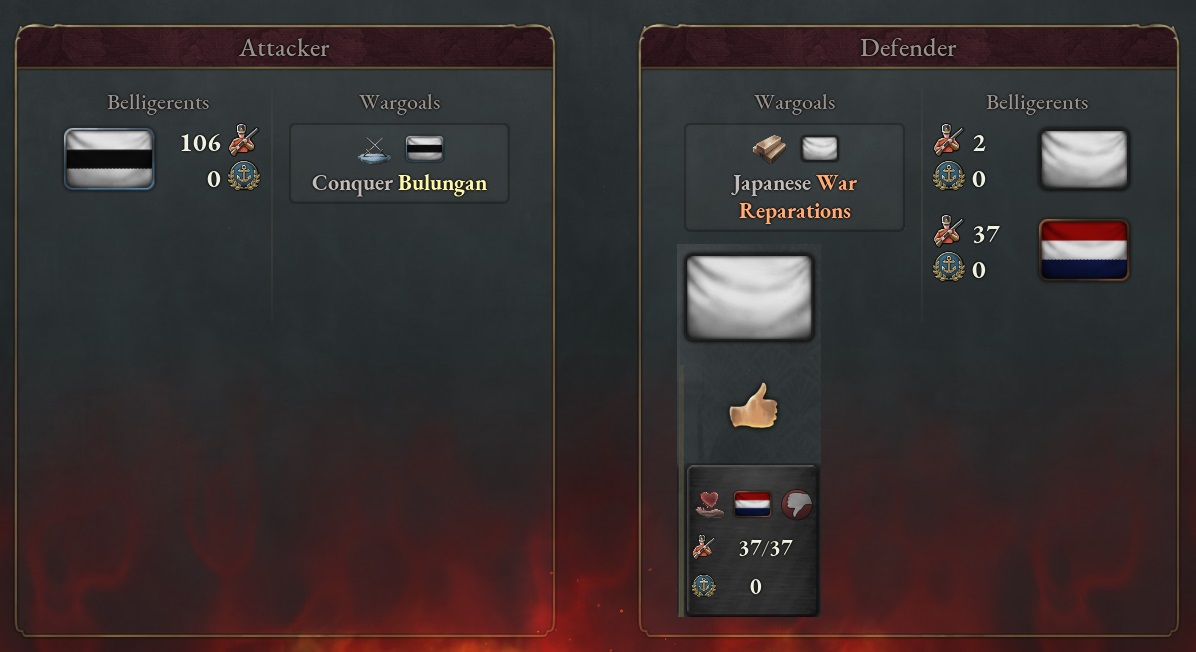
For a simple obligation, Japan now faces Dutch East Indies
As Japase forces crossed the border, a single diivsion was intercepted by Bulungan force and the first battle since the end of Sengoku took place. It did not end well for Japan, with about 10th of force being killed and half wounded in battle.
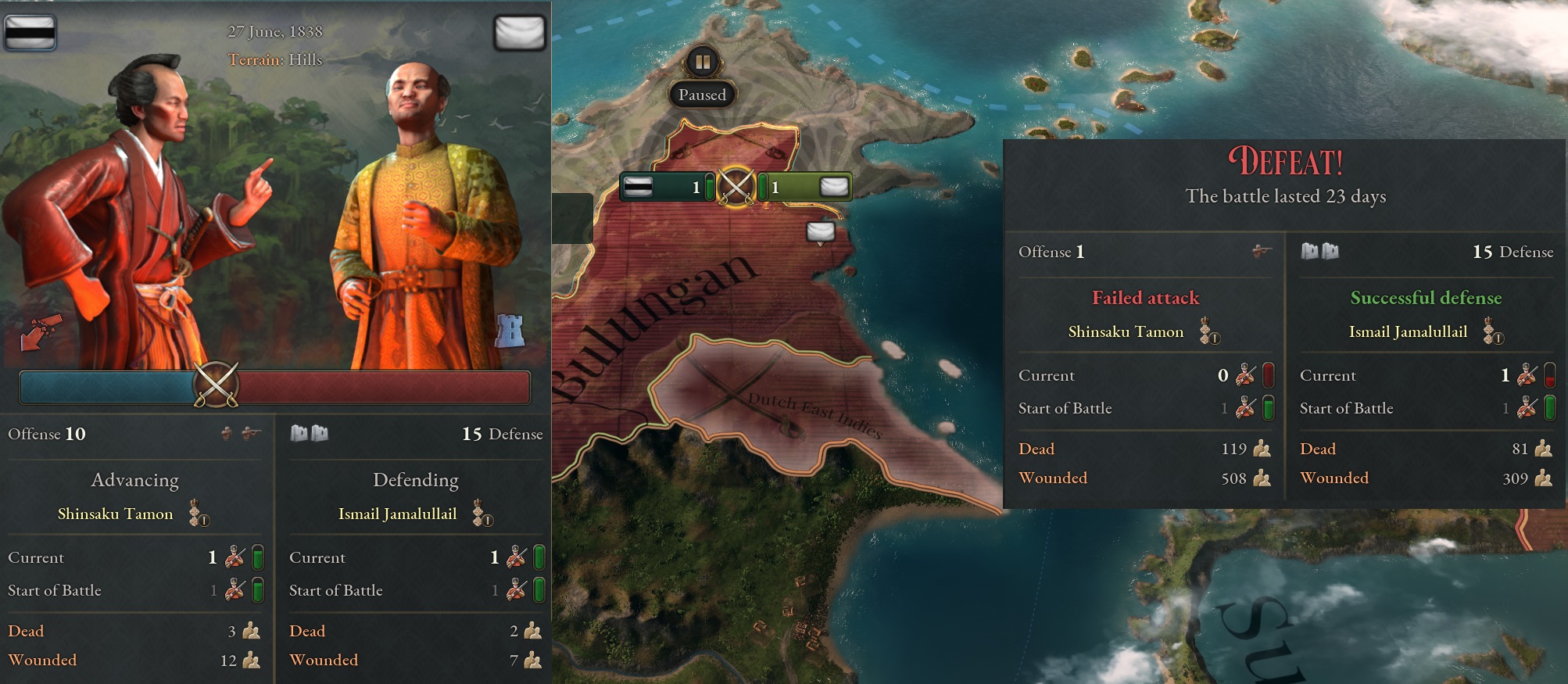
The first battle of Japan in more then two centuries. Did not go too well.
This was just a first battle though, and the others went a bit better. By August, the northern part of Bulungan was under Japanese control and the Japanese reached the borders of Dutch East Indies. Only to find their armies deeply entrenched there, but without general and just defending, not attacking.
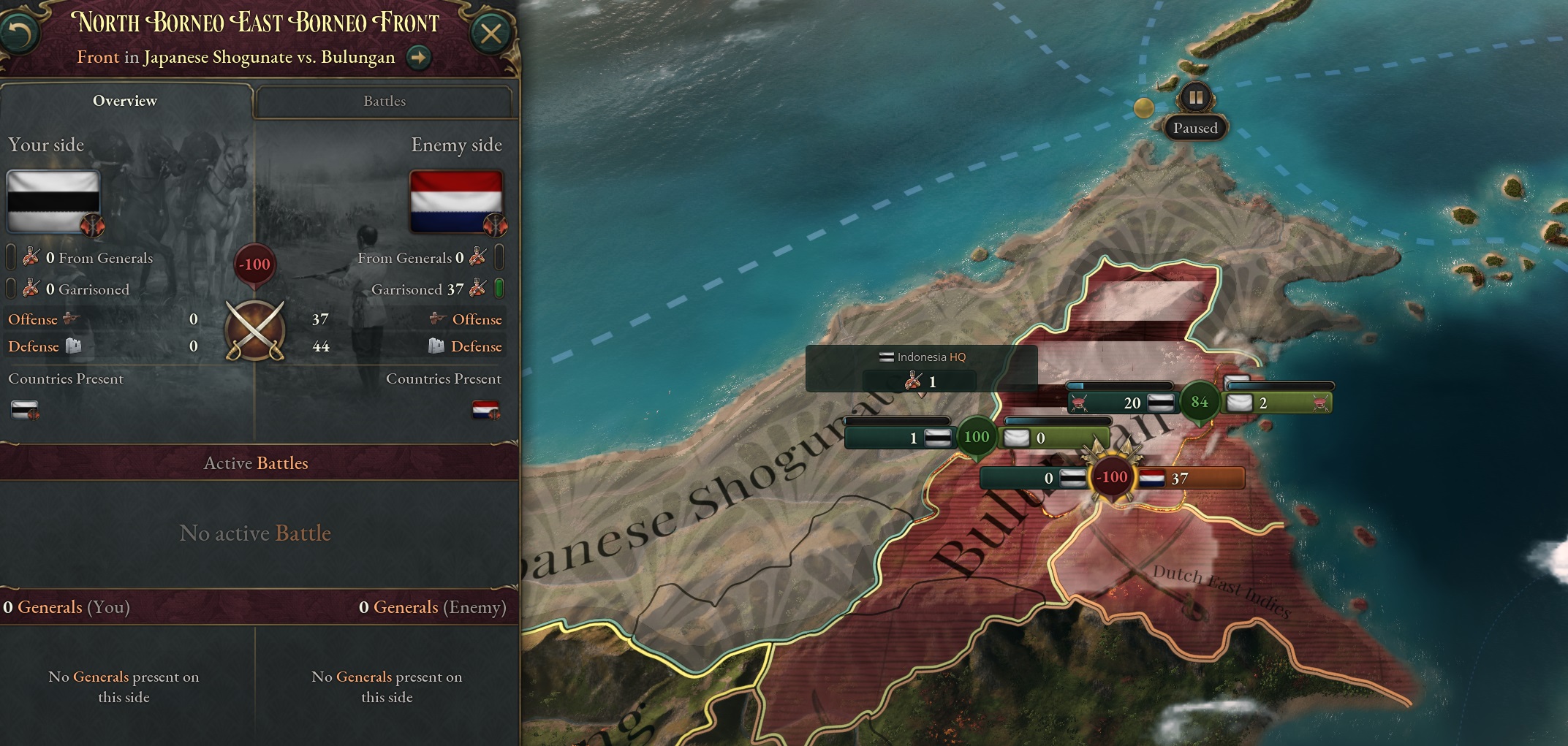
I'm gonna stay away from this front for sure
The Japanese were also not keen on attacking, for the Dutch were better armed, better positioned and it was clear that the medieval force of Japanse Empire would be slaughtered by the modern Dutch army. Instead, the Japanese focused on occupying the Bulungan lands, for this enemy was weaker and much less in numbers.
Until in 16tth January 1839, Bulungan gave up, ceding their East Borneo lands to Japan. The Dutch East Indes were like “Ok then” and ended the war as well. Japan got another bit of territory in the Boreno island.
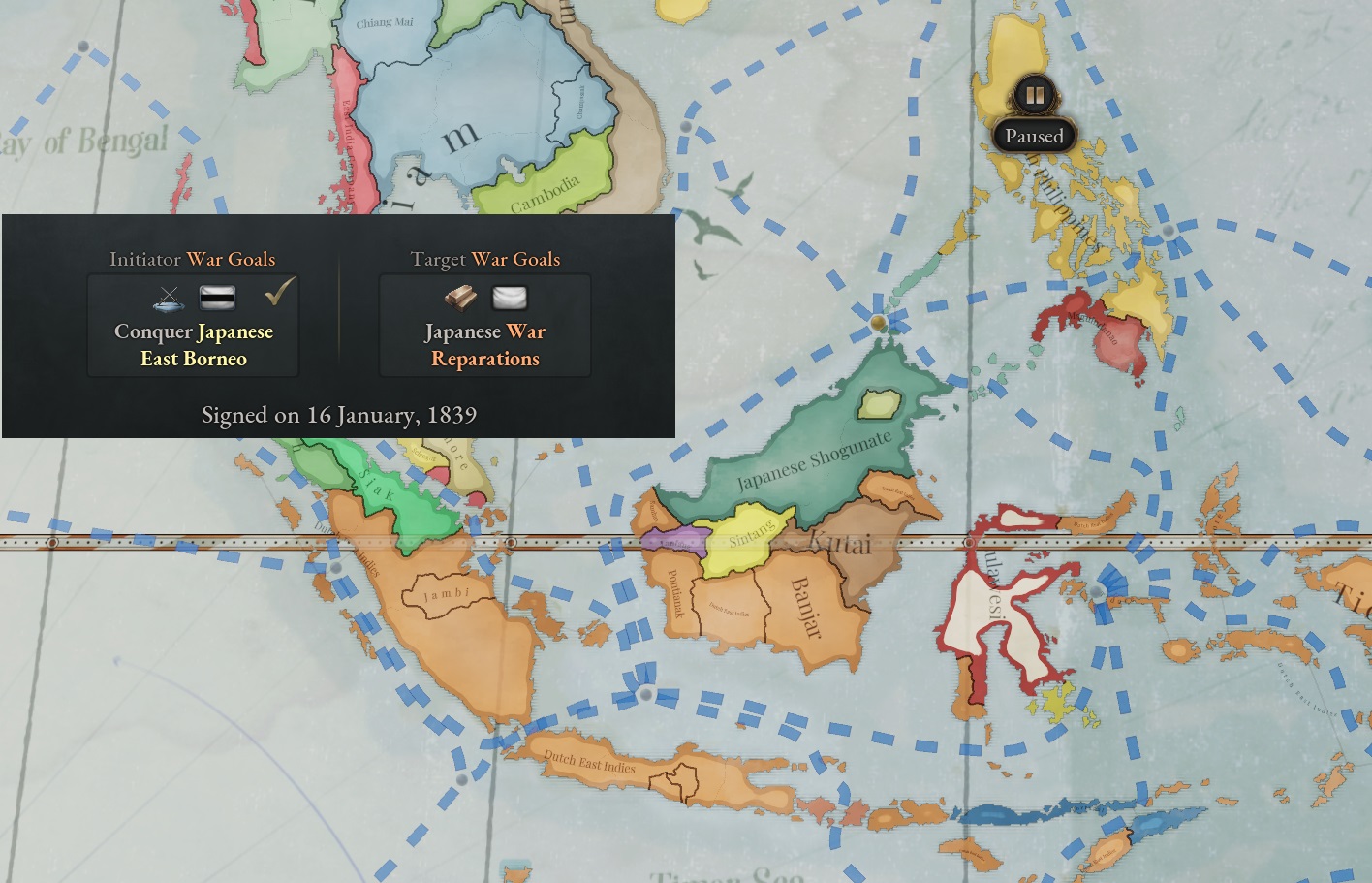
This went surprisingly well
- 2
I'm not quite sure what happened here. The Dutch had their army in Borneo, but apparently, not led by general, just garrisoned there. If they had went on offensive, they would have wiped the floor with the Japanese army. But they did not do that, so as they say- never look a gift province in the mouth. Still, weird.
Well, you got there eventually.
And yes, it at least allows me to use a different economic model and kicks back the Shogunate faction a lot.
I personally think aristocracy is named a bit wrong. Most of other factions as well, but just renaming aristocracy to "Old guard" or "Traditionalist" or something similar would help. People who are happy with the way things are, because that's the way things are and have always been. And if they're not they way they used to be, they long for the good old times and want to bring them back.
Intelligentsia renamed as "Progressives" or "Blasted Liberals" or something as people who want change.
Etc.
Meaning that IG-s are based on ideology and people who are attracted to the ideology join them. Aristocrats would prefer traditionalist IG because they prefer to keep the status quo etc.
Would kind of make a bit more sense.
Lucky you, no one has moved mine yet, despite me pinging Qorten on Friday.
As for the update, an important step indeed!
Well, you got there eventually.
And yes, it at least allows me to use a different economic model and kicks back the Shogunate faction a lot.
See, reading this as my political scientist self, I get bothered by the assignment of the "radicalization" label for the aristocracy. I feel like there should be an ever-present struggle between the radicals and reactionaries (think of the power slide in HoI4 with the Italy update) where going too far down either path would lead to the crack down or revolution. Seems like that would be a better representation than all groups being lumped together as "radicals."
I personally think aristocracy is named a bit wrong. Most of other factions as well, but just renaming aristocracy to "Old guard" or "Traditionalist" or something similar would help. People who are happy with the way things are, because that's the way things are and have always been. And if they're not they way they used to be, they long for the good old times and want to bring them back.
Intelligentsia renamed as "Progressives" or "Blasted Liberals" or something as people who want change.
Etc.
Meaning that IG-s are based on ideology and people who are attracted to the ideology join them. Aristocrats would prefer traditionalist IG because they prefer to keep the status quo etc.
Would kind of make a bit more sense.
- 1
Shogounate colonies look good. Except that enclave. Got to get rid of it. No? 
- 2
Not a typo. "I am assured of this." - LT Nate FickYorkshite
Change in Governance
Change in Governance
“It’s a bloody miracle,” said Jin, sipping his cheap sake.
“Are you surprised?” asked Yoshimichi, smiling from ear to ear.
“The pure amount of it... yes. I mean, Nippon was a few thousand pounds in the red yesterday. Today, suddenly, we are 11 000 in the green. Eleven thousand!” Jin said, with amazement. “I mean, I knew that the system was corrupt, but to that extent???”
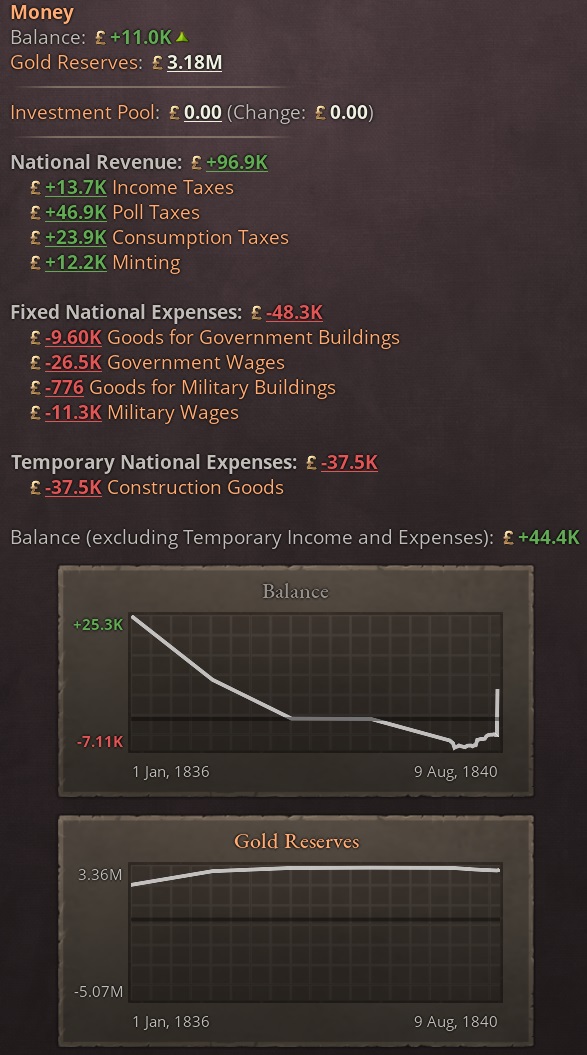
Quite an impressive change in balance
“I heard even Tokugawa Ienari looks really happy,” added Yoshimichi.
It was 9th of August 1840 and Japan had finally approved Appointed Bureaucrats. The changes were instantaneous. A budget that was slowly drifting to negative was hugely positive again.
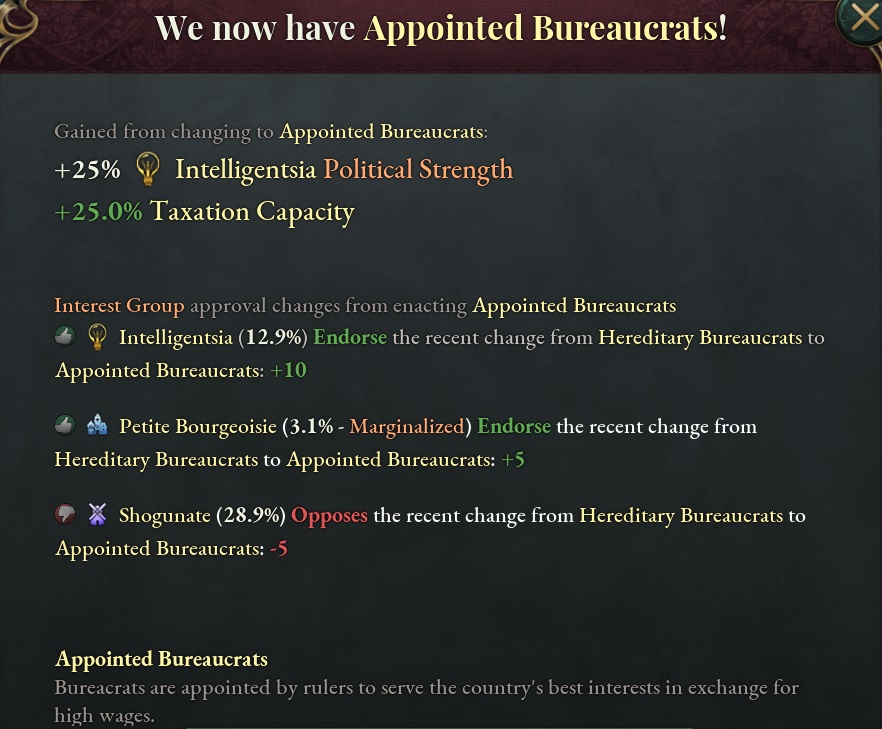
Finally
“No wonder there was such an opposition to the law,” said Jin.
“From November 1837 to August 1840. Almost three years,” Yoshimichi agreed. “With the decree from Shogun that insisted that it should be implemented as soon as possible, no less”
“Oh yes, we got bureaucratic struggle, adding extra enactment time. We got splitters from intelligentsia, who decided they did not want the law. But in the end, we got what we wanted!” said Jin. “I had given up hope already.”
“Now what?” asked Jin
“Now, the daimyos are pissed,” replied Yoshimichi. “But we do not want them too pissed. Yet. Instead, I propose we do something that does not piss them off anymore. How about bringing the Samurai back to the fold and do something that makes intellectuals angry?”
“Like?”
“Like implementing the national guard. I would love some secret police, but we just don’t know how yet, so the national guard in the meantime should work ok. And it makes intellectuals less angry when it is time to implement the secret police.”
“So, no serious reforms until daimyos have cooled off a bit?” asked Jin.

Now, going for a National Guard. Meaning, if you don't agree with the government, you shall receive a free bonk in your head.
Yoshimichi nodded.
“Oh, congratulations are in order, right?” said Jin. “You industrialists are finally not marginalized. In fact, your power can be compared to samurai.”
With a smug look on his face, Yoshimichi agreed. Things were looking up for Nippon.

Time for samurai to be in power again. And, look at the power of the industrialists!
The Industry Grows
In April 1839, first arms factory in Japan was completed. Yes, it was producing both small arms and cannons and yes, the small arms went totally to waste, but Japan had cannons. Some cannons. Not enough to rearm everyone, but the troops under Tamon Shinsaku got equipped with cannons. Again, not enough to meet the Duch East Indies in battle, but increasing their success chance if that happened nevertheless. And also, giving the Japanese a definite edge over other unrecognized powers of the area.
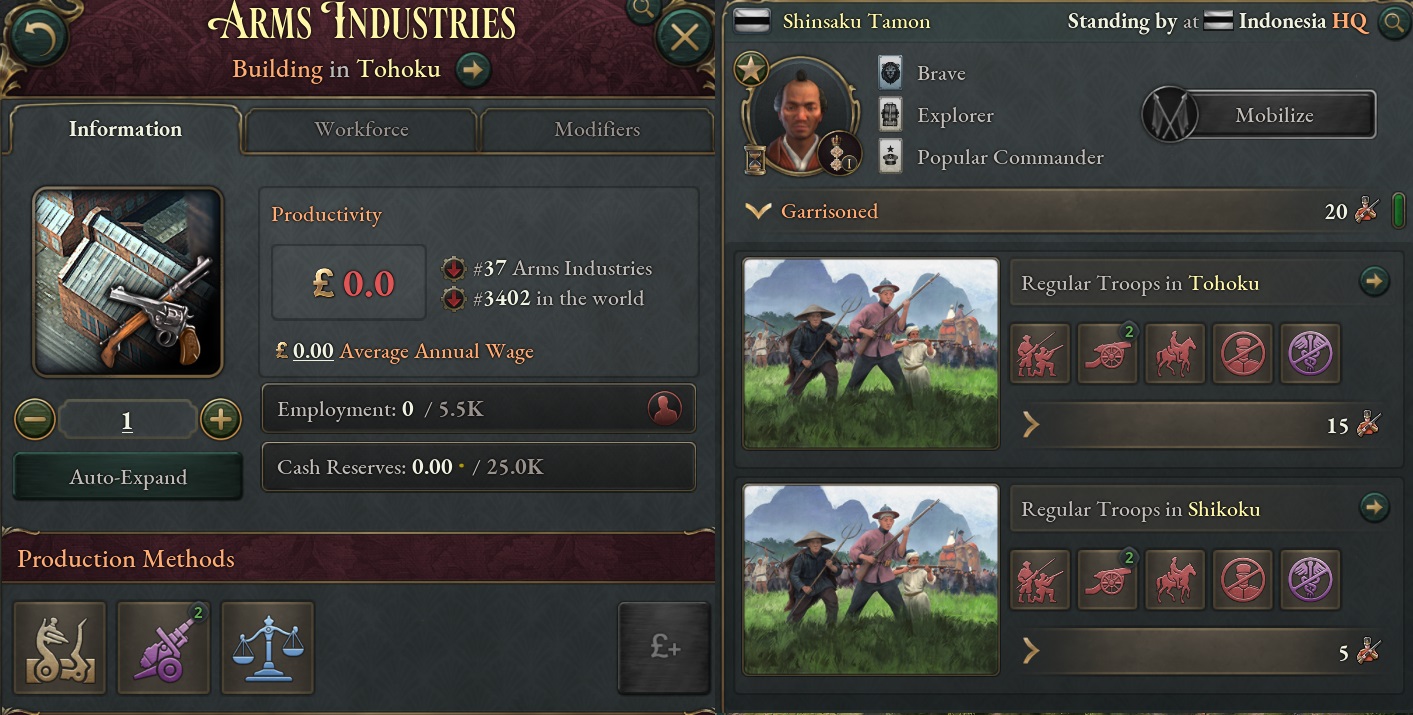
First arms industry, plus Tamon getting first cannons
Meanwhile, lumber production had more than doubled since 1836, though demand had skyrocketed as well. Still, in the course of a few years, Japan had become the 4th producer of lumber in the world. Also, it was obvious that the economic change initiated by Yoshimichi was a great success. Once, lumber mills produced less than half of what subsistence farms did. Now, they produced over twice the amount. Proving to everyone that mechanization was the way to go.
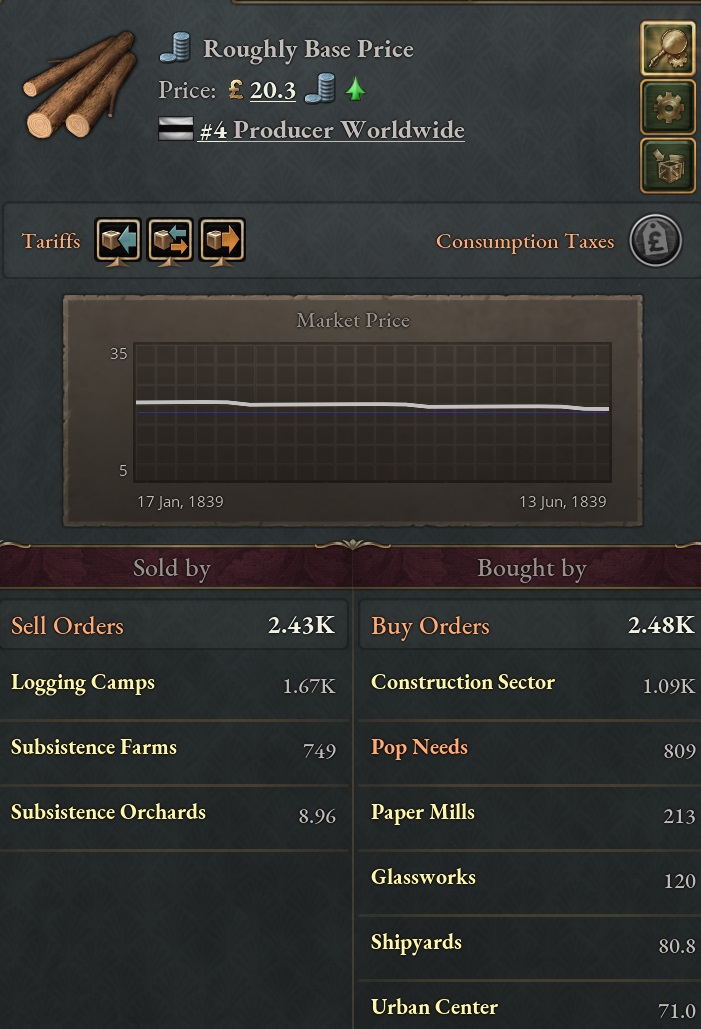
Lumber, the driving force behind Japanese industrialization
Western influences helped Japan to unlock the Currency Standards. Allowing Japan for a new, better system of collecting taxes from the population. If only the economic system wasn’t traditionalism. And imagine the shock of the Japanese when they first saw a Dutch paddlewheeler in 1835. Few would have imagined that in November 1839, the first Nipponese paddle steamer would come into service. Yes, ordered from the Dutch, built in dockyards in Amsterdam, but sailing under Japanese flag. The ship sailed mostly in Seto Inland Sea, carrying cargo and passengers between Shikoku island and Honshu island, the main island.

These are due to influence from other countries
The gold rush of Borneo did not last for very long. Already in September 1839, four gold fields were depleted. Meaning, no more easy pickings and Japan lost an important source of income. This was a blessing in disguise though, for the gold was still there, just needed proper mines to be built. In future, the gold mines would for sure be able to produce gold in greater properties then the greediest army of men armed with pans. Just, it takes time to build.
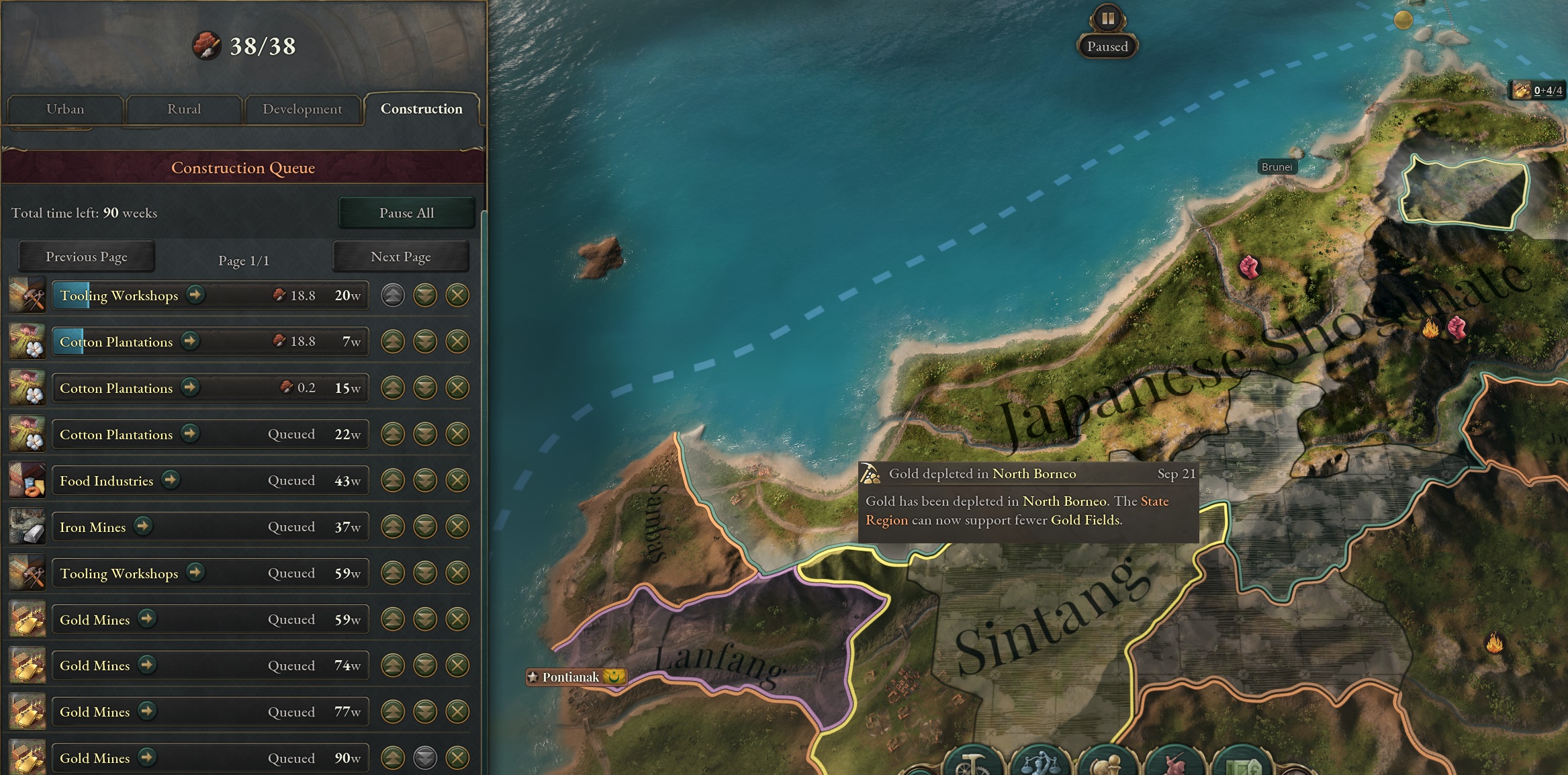
So long, easy income. Welcome, more easy income in the future
By March 1840, the first cotton plantation were built. The price of fabric went a bit too high, so in order to cut the funding costs of the construction sector, some specialized cotton was needed. Of course, this was not in a scale as lumber and most of the fabric still came from subsistence farms, but it was a start.
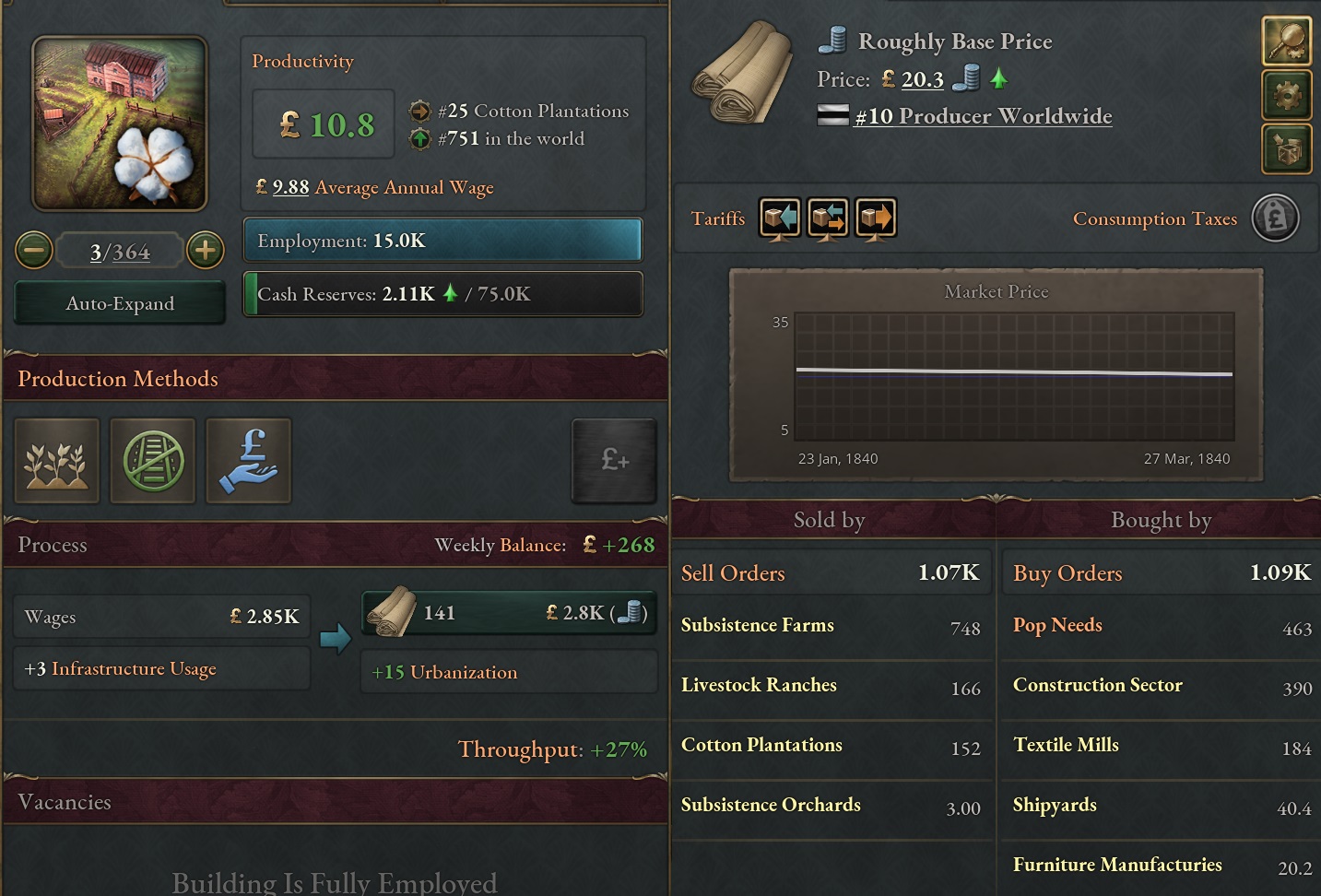
First cotton plantations and the demand for fabric
In July 1840, the first food industry was built in Chubu. Using sugar and grain to produce both booze and groceries, it was a first industry that managed to make some food that would preserve for quite some time and do it industrially. And make a sake that is cheap, but not total swill.
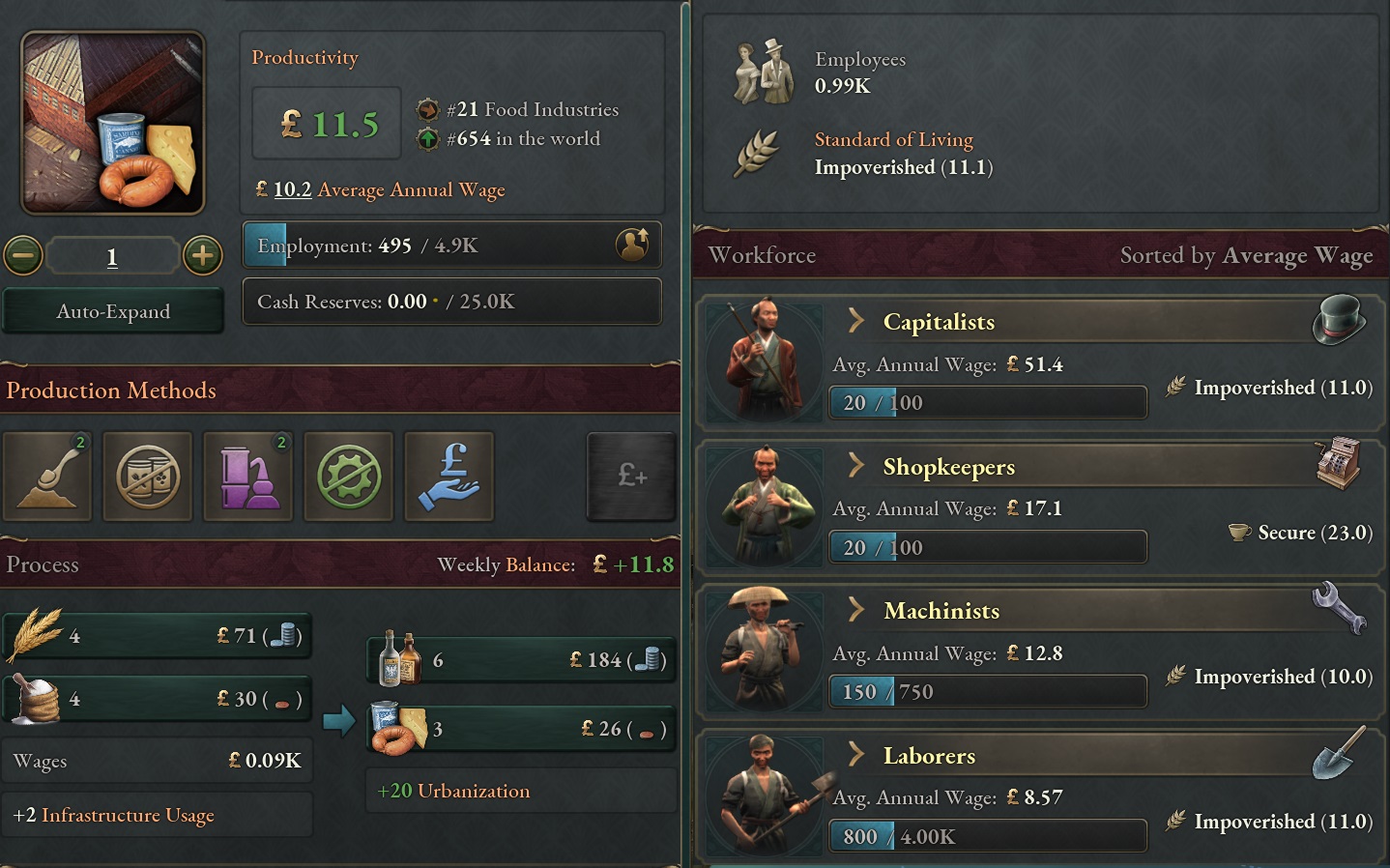
First food industry.
Into West Borneo
Sintang was a small nation in Borneo. Offshoot of Lanfang, the Chinese tributary, the nation was totally inland. Recently, some gold fields had been discovered in West Borneo as well and Sintang also had one. So, on 17th January 1840, Japanese started play to occupy them. As usual, Tamon Shinsaku was mobilized and sent to the border. His 20 000 army against 2000 of the opposing force. Just, now armed with cannons.
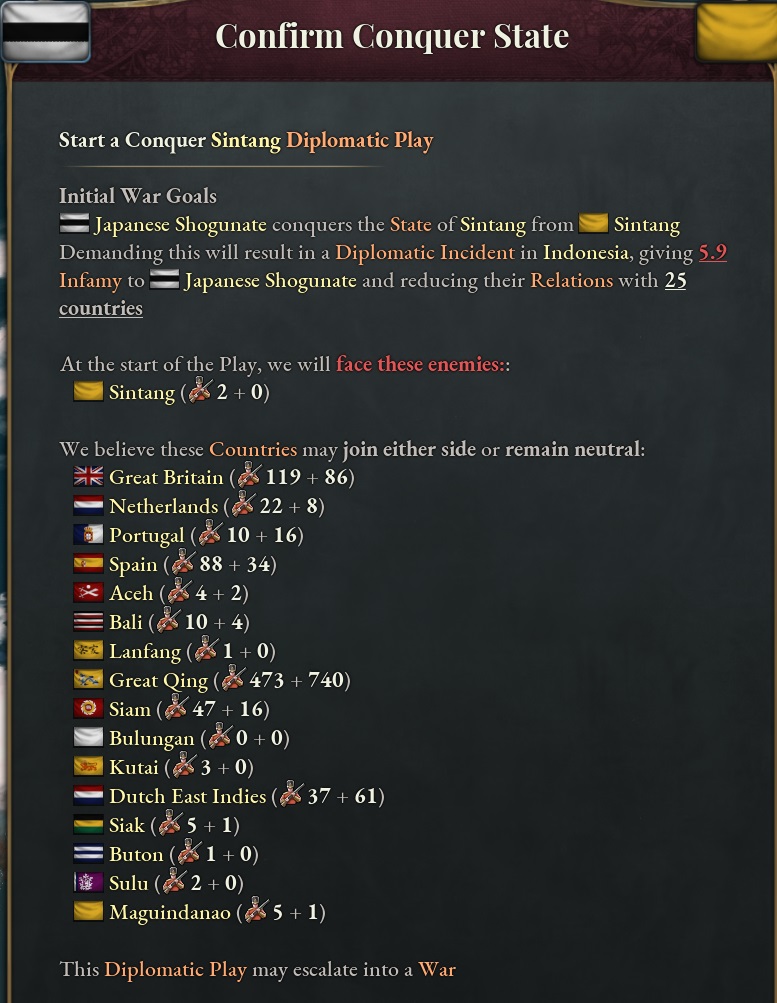
Further into Borneo
The thing is, Dutch East Indies were unable to support them, for they had a truce with Japan. Other powers in the island were also not really interested in helping out. So, on 1st of May, Sintang gave up, leaving their province (and a lot of unpassable territory) to Japan.
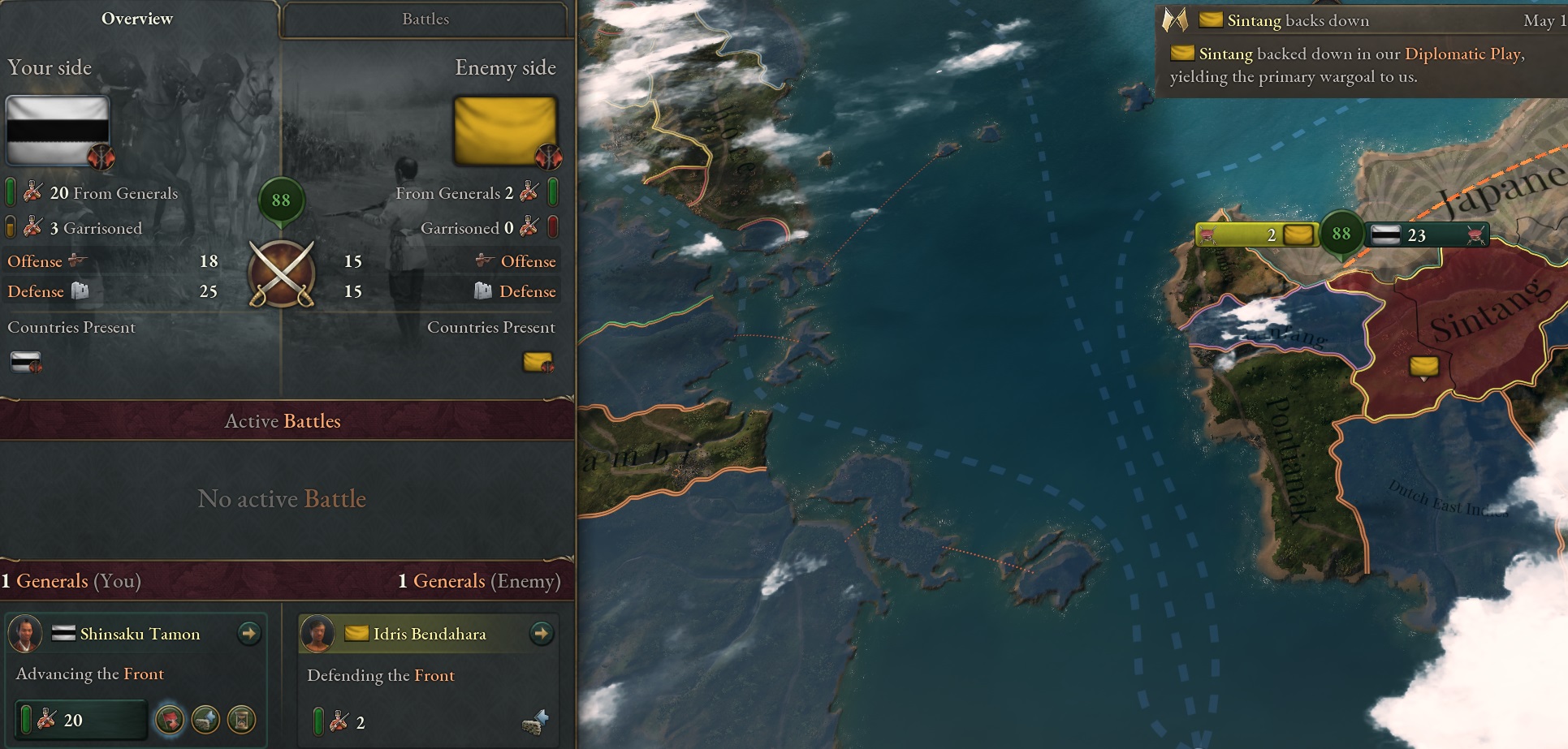
Poor Sinfang. All alone against the evil Japanese
The main value of Sintang was its gold field. As for the rest of the state, nothing special. Still, it was the first entry of Japan into West Borneo. And this one is a tougher nut to crack, for it is either under direct or indirect control of Dutch East Indies or under Lanfang, a tributary to Quing. Japan is not ready to pick a fight with either of them.
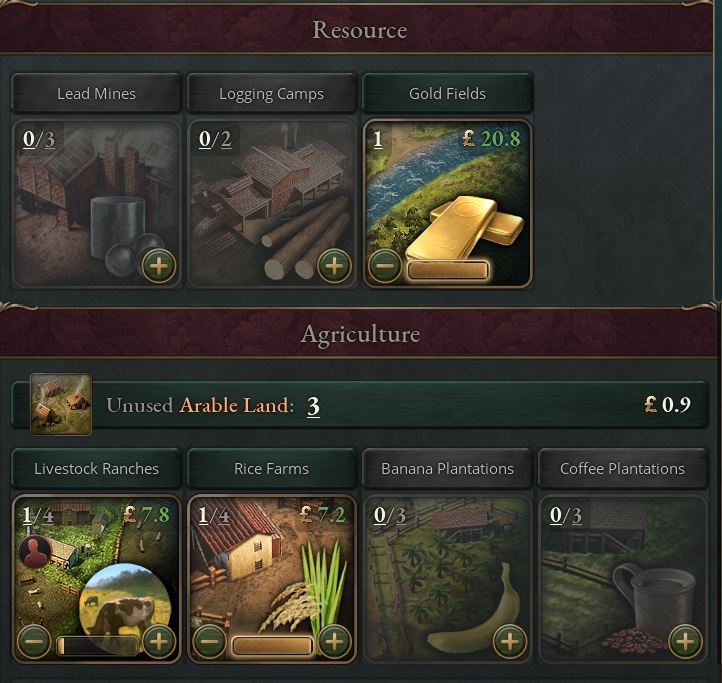
Gold and some other things.
- 2
It truly is amazing. Sack some lazy thieving hereditary bureaucrats and suddenly, your income grows around 15 000. A miracle indeed!
Most shall be invested into construction, of course.
Also, steady growth of industry. Tooling industries growing, more iron being mined and such. Plus some more. By the end of 1840, construction is already 45 and i'm still not bankrupt.
And I kind of hoped Lanfang would come to the rescue of Sintang, but alas, that was not to be. I think Qing would not cared if they did. Alas, can't have it all.
Well, these are remnants of once mighty Buluangan. Cannot until truce runs out
Heh. Definitely not fixing this one
Most shall be invested into construction, of course.
Also, steady growth of industry. Tooling industries growing, more iron being mined and such. Plus some more. By the end of 1840, construction is already 45 and i'm still not bankrupt.
And I kind of hoped Lanfang would come to the rescue of Sintang, but alas, that was not to be. I think Qing would not cared if they did. Alas, can't have it all.
Shogounate colonies look good. Except that enclave. Got to get rid of it. No?
Well, these are remnants of once mighty Buluangan. Cannot until truce runs out
Not a typo. "I am assured of this." - LT Nate Fick
Heh. Definitely not fixing this one
- 1
Gold! A commodity only, ahem, responsible industrialists should deal with.
- 1
The Solid Black Gold
The Solid Black Gold
It was in March 1841 when Japan discovered the first practical steam engine- atmospheric engine. Mostly used by mines to pump out water. Allowing to dig more greedily, more deeper, until you awaken some monstrosity deep in the mines.
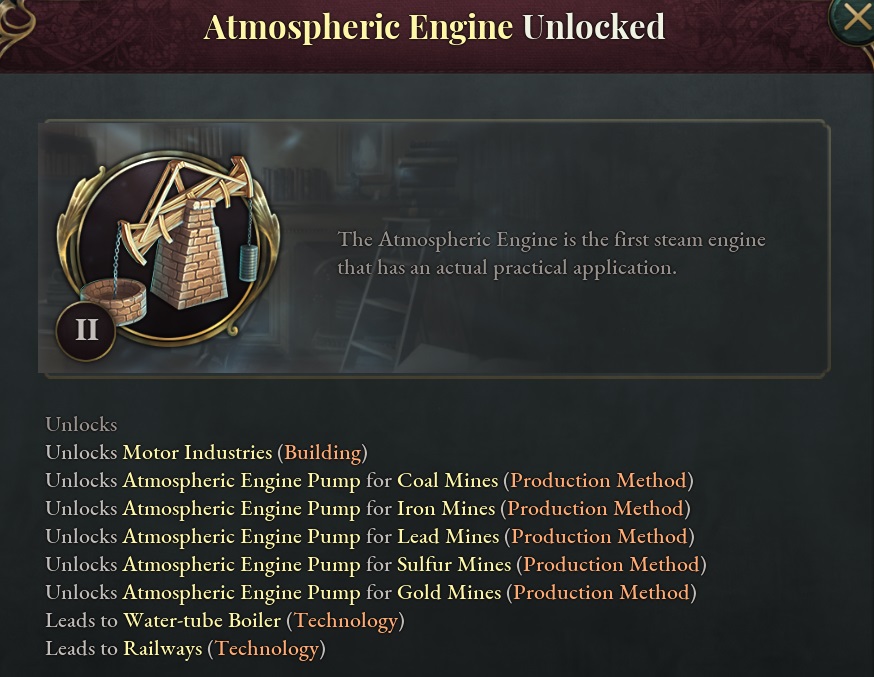
A new era begins
The thing is, these engines need coal. And a lot of it. Fortunately for Japan, there was plenty in Kyushu island in the south and also in Hokkaido island in the North. In fact, two coal mines were already under construction in Kyushu, in anticipation of the first engines.
In May, the first coal mine was completed, with the second one expected to be finished in a few weeks. They were also the first ones to actually use the atmospheric engine. Kind of handy when there is coal supply nearby. Soon, the production was up and running and Japan officially entered the industrial era. First chimneys pumped black smoke over the neighborhood as miners with dirty faces and even dirtier clothing entered the ground to bring up as much black gold as possible.
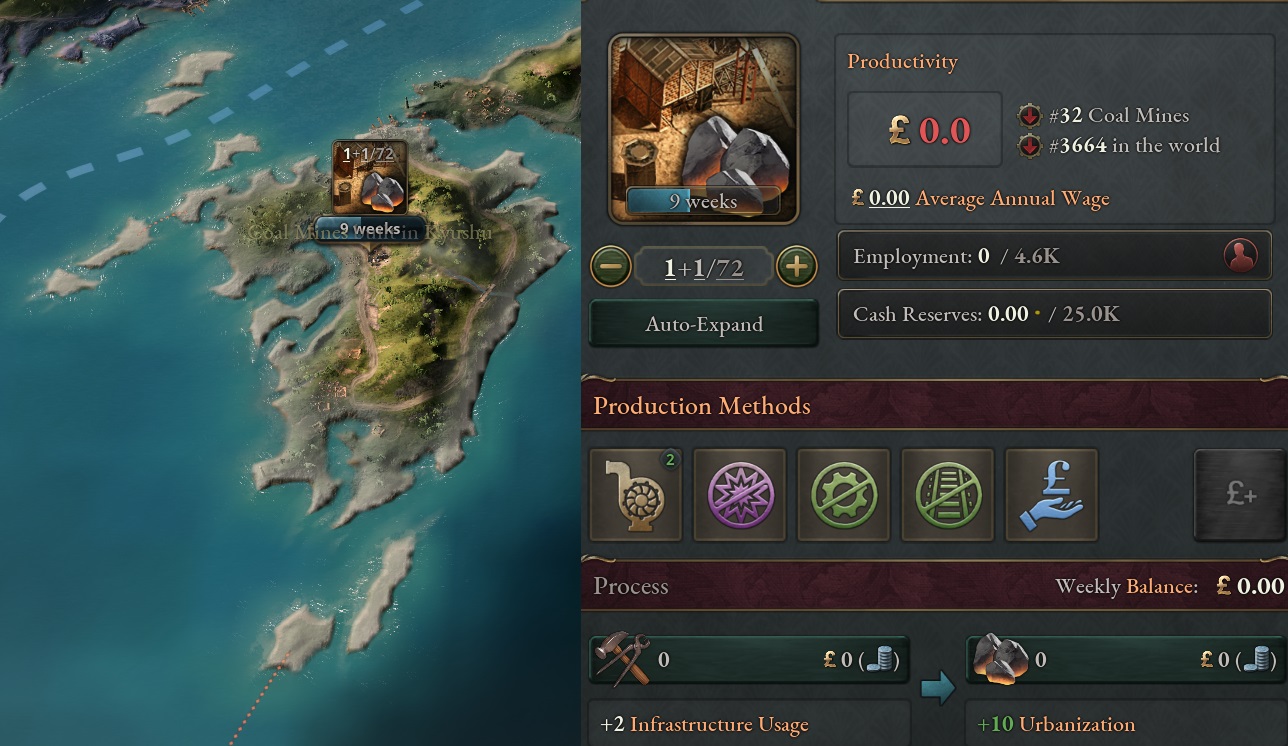
The first coalmine
And the first one to adopt the new engines (apart from the coal mines themselves) was the lead mine in Chugoku. Again, as usual, disrupting the social order or the mining business while doing so. Suddenly, the shopkeepers dealing with the mines became capitalists, and as usual, some machinists popped up. Someone has to keep these pumps flowing. Another side effect was that there was enough lead that every glass factory in Japan now switched over to leaded glass. Resulting in surplus in glass that again resulted in fresh new market stalls being introduced in Edo.
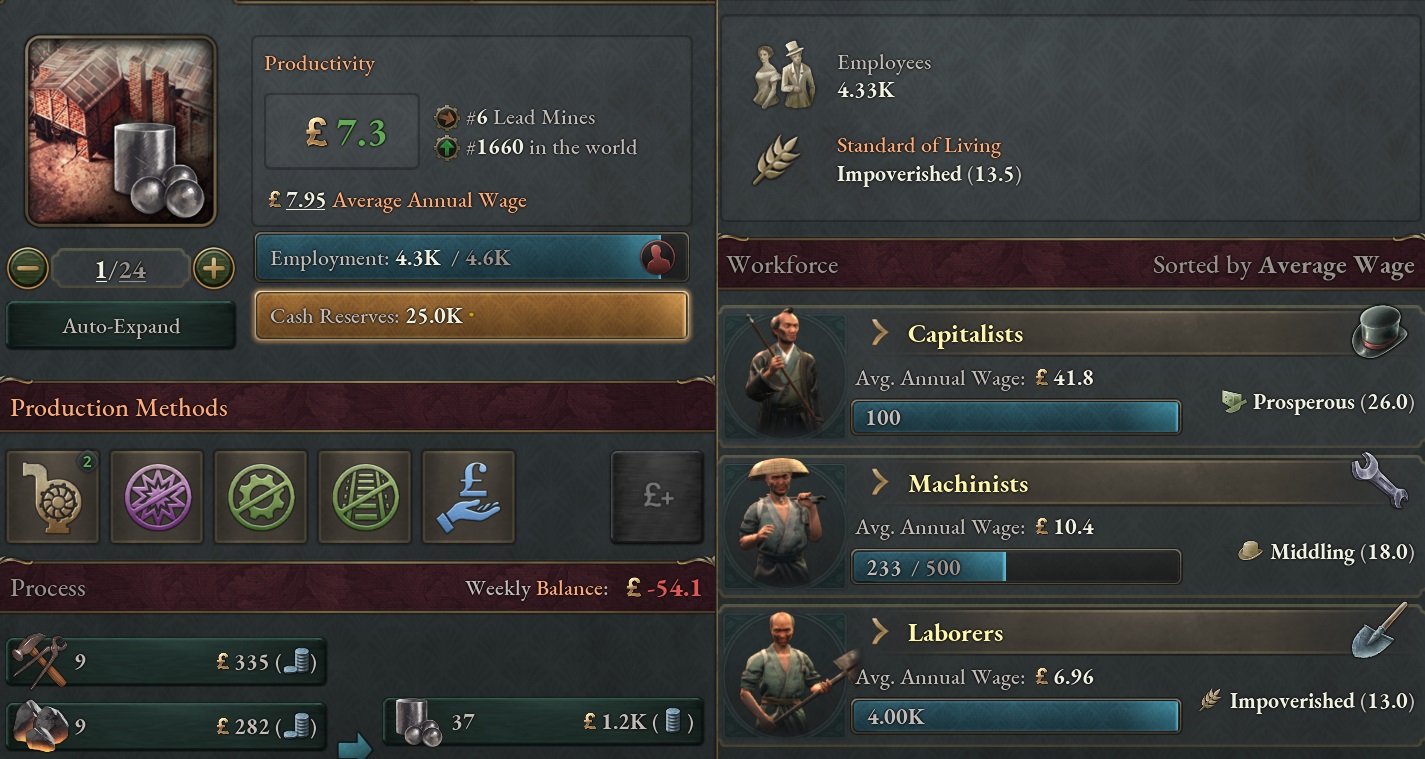
First mine to adopt new methods and new leadership
In June, the amount of coal produced was enough that the iron mines in Kanto got an upgrade. Yes, suddenly the demand for coal skyrocketed, but another mine was coming and the first one was still picking up speed. And even that was enough to make the price of iron go down. Considerably.
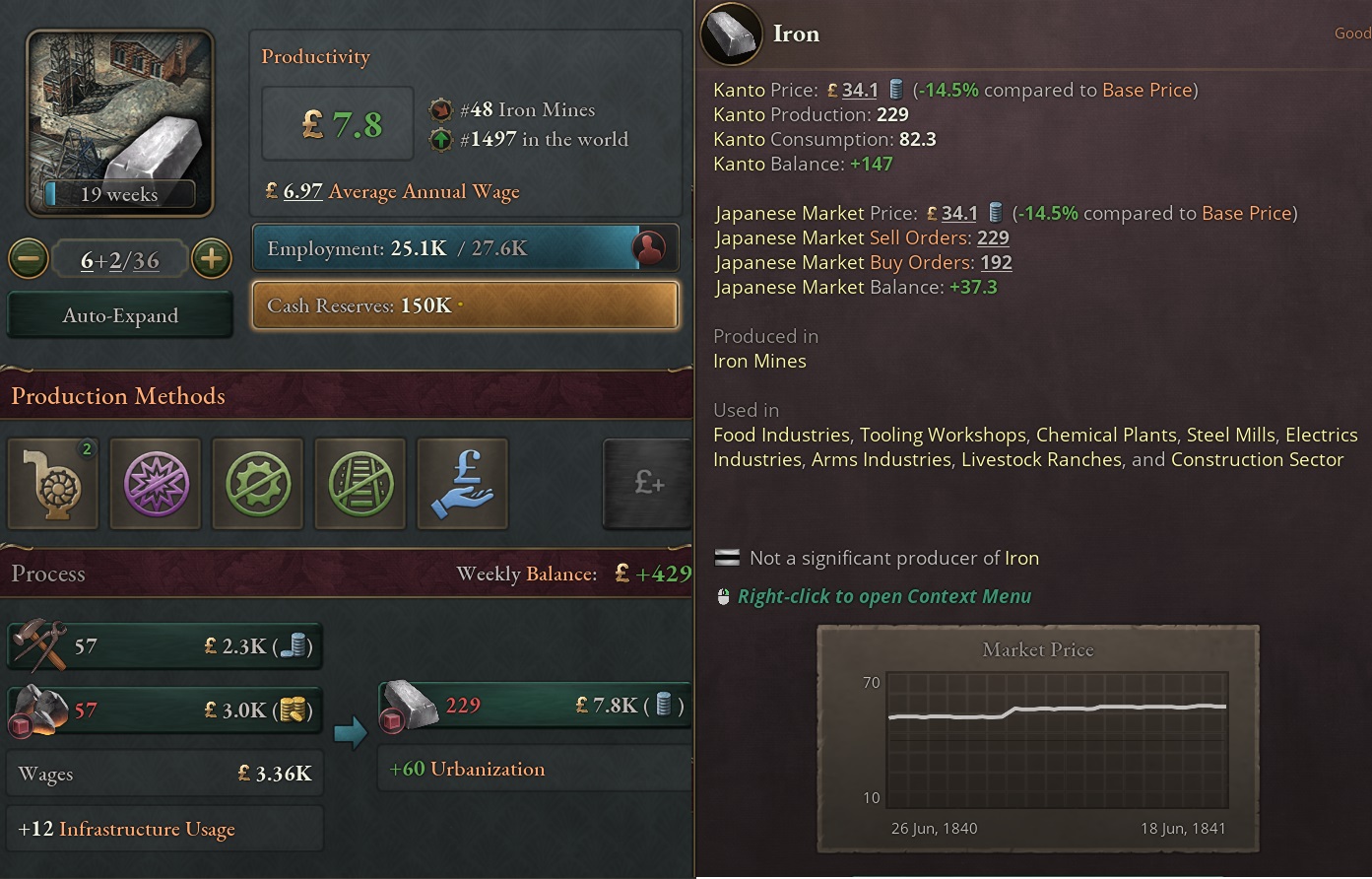
Skyrocketing demand for coal, but the production of Iron goes boom!
The price drop was actually enough that the very next day, the construction sector in Edo switched over to iron-frame buildings. And the Japanese budget switched from being around 10 000 pounds surplus to about a thousand in negative.
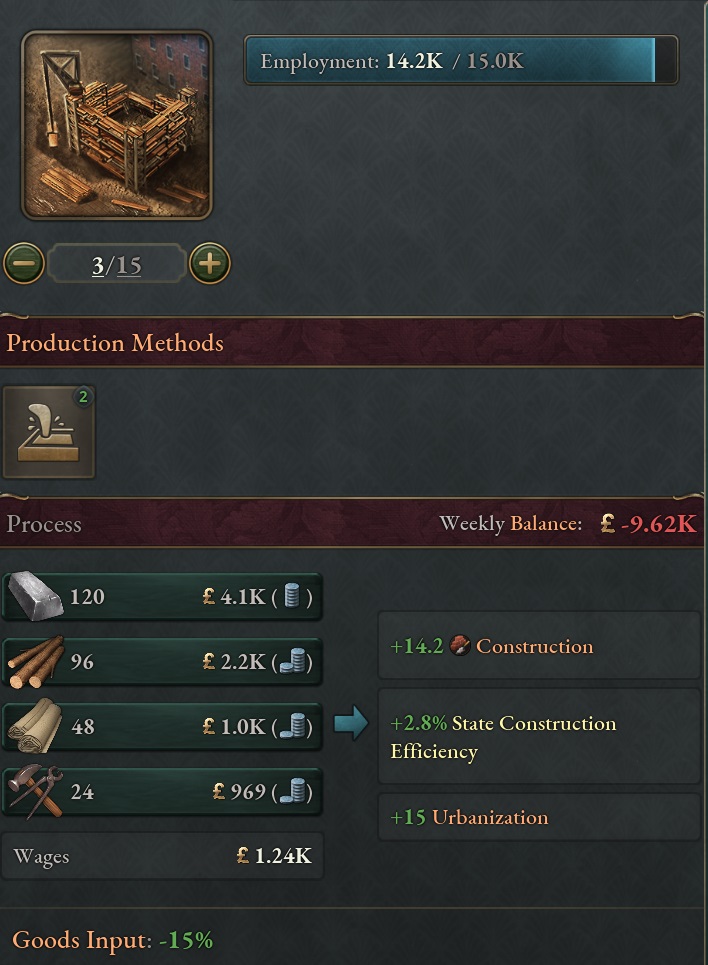
And all the surplus iron goes to Edo!
This was rectified in September. With the new coal mine complete in Kyushu, Japan now had enough surplus to change the production of gold mines in Borneo. The results were staggering- from 2000 pounds per week to profit of 4000 per week that goes straight into the treasury. Gold really-really helps to keep the budget above 0.
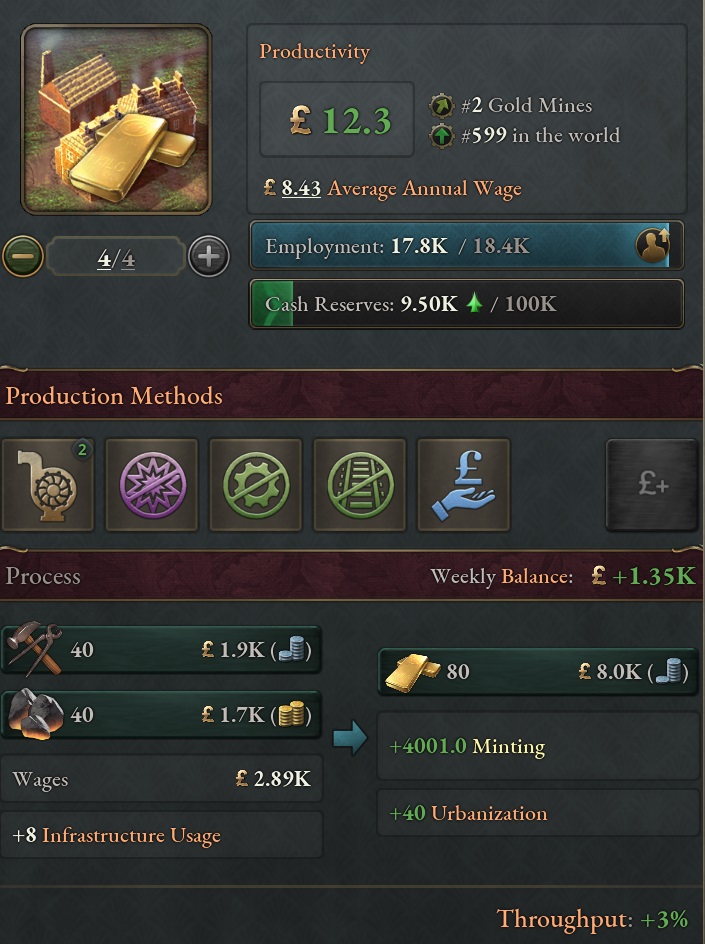
All this sweet-sweet gold
It can be said that moving from more traditional methods to coal and steam is the true beginning of the industrial revolution. And Japan had just started it. At least in the mining sector, but that is a good start. The influx of more capitalists surely helps as well, for the Industrialists are growing in influence. With just a few years, from marginalized to around 10% of support is not bad at all.
And by January 1842, the coal mines in Kyushu had grown quite a bit, and were still making a profit. Steampower was here to stay.
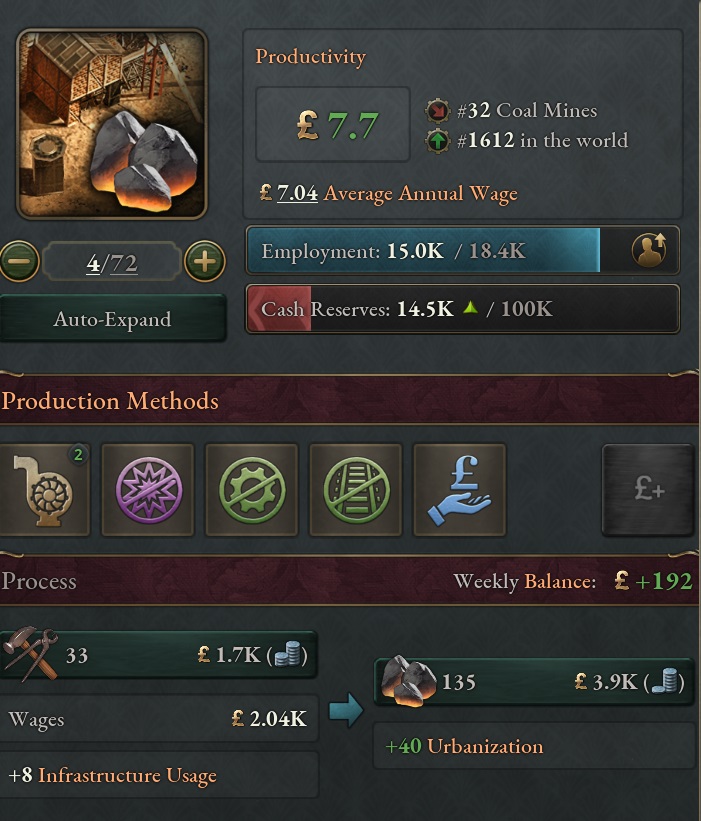
Coal is a hot commodity in Japan now
Conquest of Kutai
Kutai was the last of the independent states in Borneo. Yes, about a third of the island was still under direct or indirect control of the Dutch East Indies and Lanfang, a Chinese protectorate, was there too. But the island was fast running out of countries that were truly free. And in April 1841, the Japanese started their play for Kutai. As usual, Tamon Shinsaku and his merry men were put on boats and sent overseas, where they spent happy time near the narrow gateway into Kutai, between the Dutch territories and impassable jungle, trying to look as intimidating as possible.
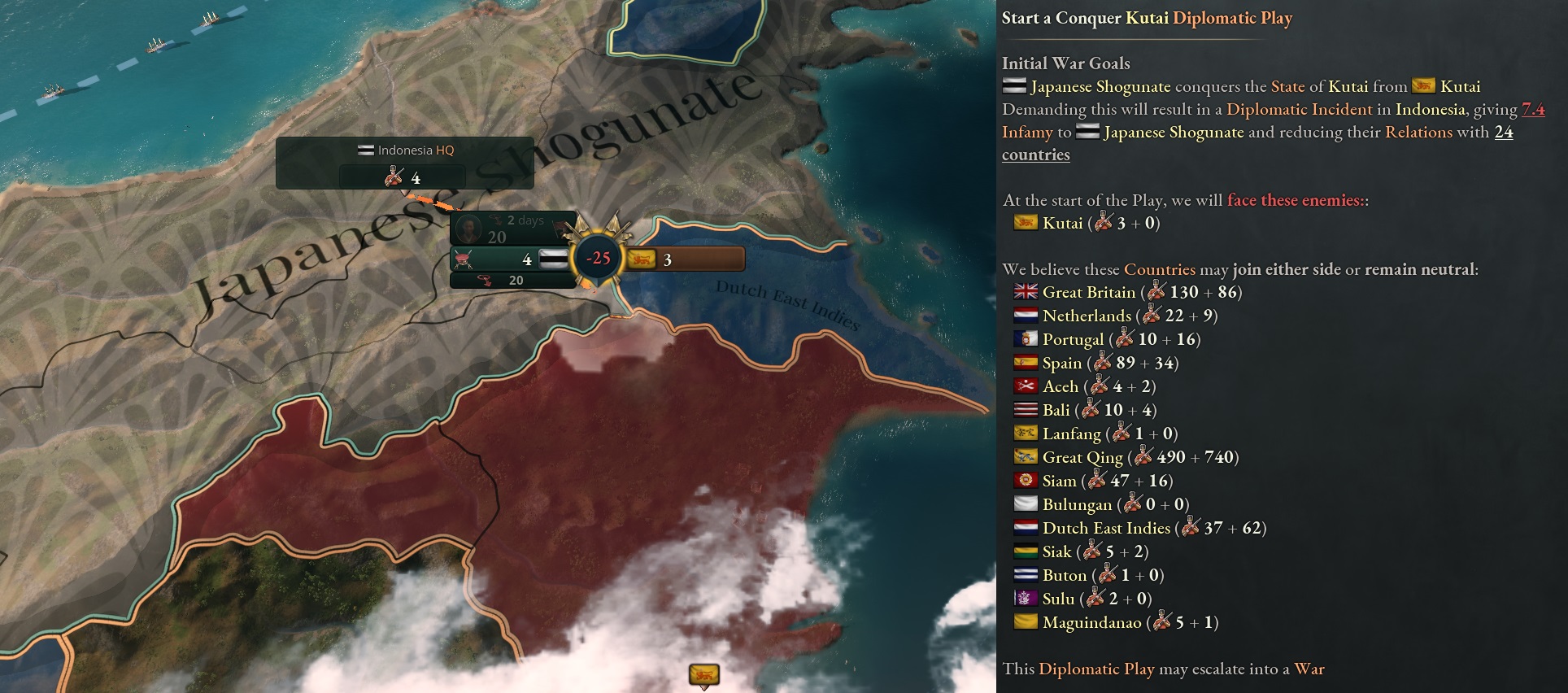
Play against Kutai, with Japanese military showing off in the narrow passageway
This worked out about as well as usual. On 26tht June of 1841, Kutai rolled over, ceding all their territories to Japan without a single shot being fired. Tamon Shinsaku was disappointed, for he really-really wanted to test his new cannons. Alas, this was not to be yet. And Japan was in a bad place now. They had taken all they could in Borneo, without going against China (too many soldiers) or Dutch East Indies (too good soldiers).
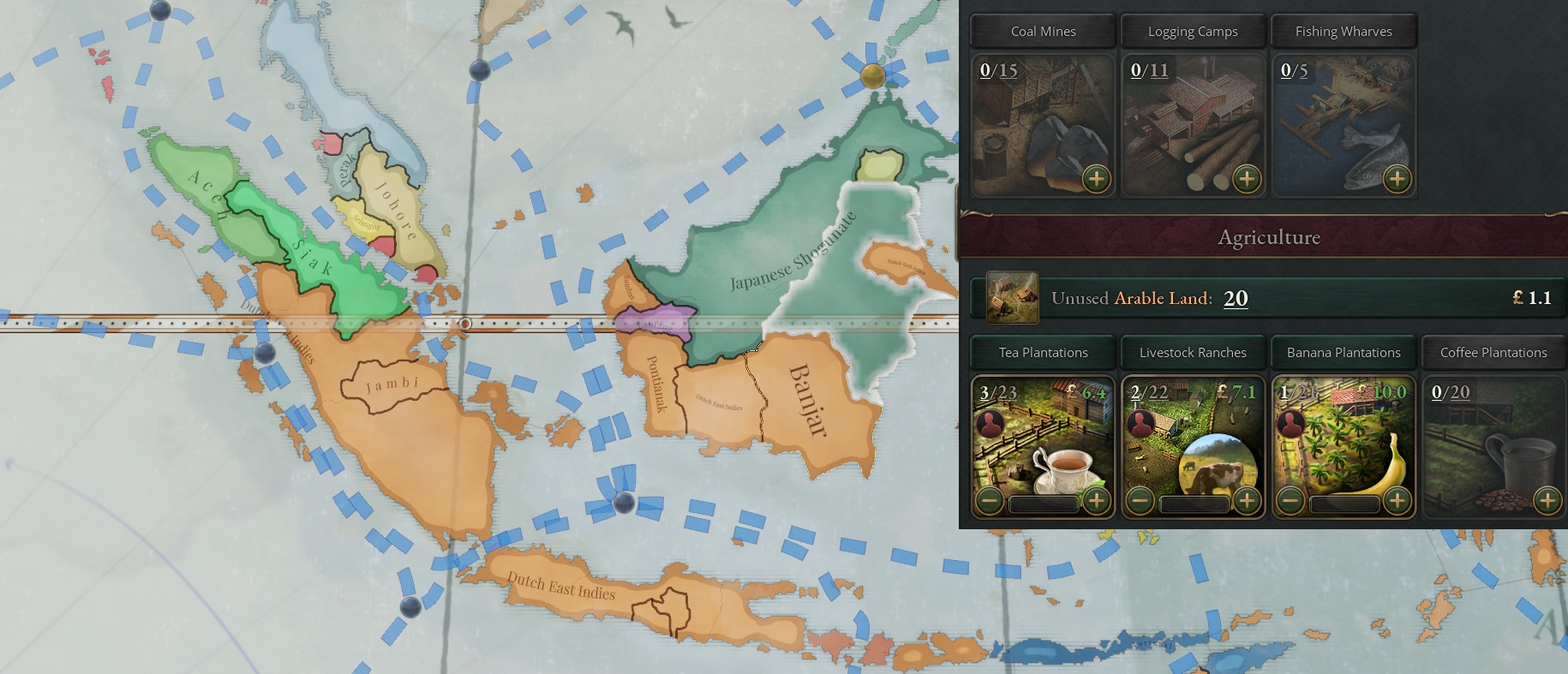
As much of Borneo as possible is Japanese
What Japan still lacked was a proper navy. Though, first steps were done to rectify this. A shipyard was being built in Shikoku island and in October 1841, the construction of 10 naval bases began in Edo. Shipbuilding is slow progress though and it would be years before Japan had a navy capable of transporting an invasion force across the seven seas. Until then, Japan had to either pick a fight with someone too strong or pick another weak nation to bluff.
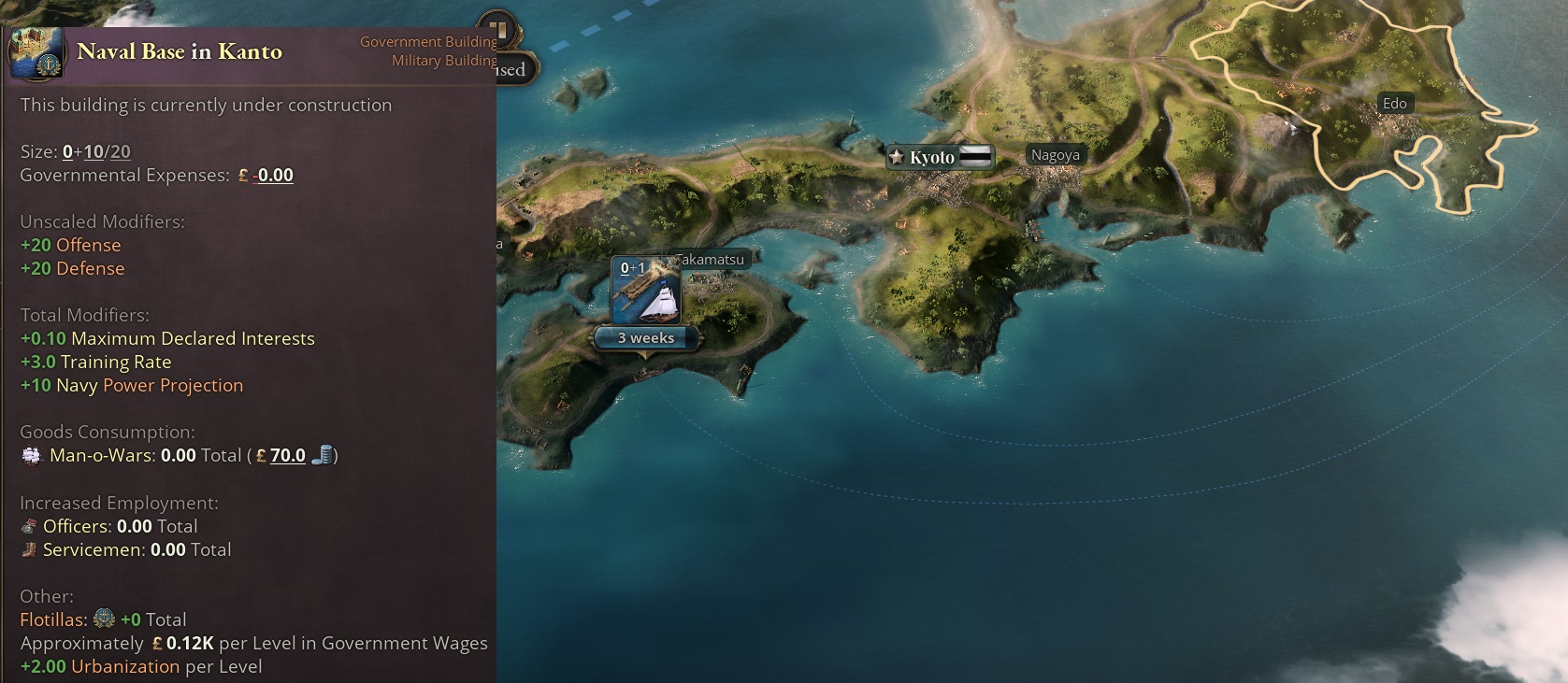
Finally, a construction of proper military fleet.
- 3
Finally, atmospheric engines and coal. With this, the mining can really take off and this is the true start of industrialization.
And oops, I think I have conquered most of Borneo.
I am more then ready to take on the responsibility for all the gold in the world!
And oops, I think I have conquered most of Borneo.
Gold! A commodity only, ahem, responsible industrialists should deal with.
I am more then ready to take on the responsibility for all the gold in the world!
- 1
Goood! How big is your gdp by now?Finally, atmospheric engines and coal. With this, the mining can really take off and this is the true start of industrialization.
- 1
This is another failing of the V3 system. The powers of the time usually contracted for development in those fields that they wanted to develop. So, the Japanese connected their navy to the RN, their army to the Prussians, etc. I feel like this would cause things to flow more naturally and that would keep things from spiraling so fast.
Convincing the Emperor
Convincing the Emperor
Today, Jin was not alone. With him was a boy, around 10 years old.
“Call him Asashi,” he said to Yoshimichi. “He is my sunlight, after all.”
With a deep sadness in his voice, he continued “And he is my fourth son. Only one who is still alive.”
With even greater sadness, he added: “Of my thirteen children, only two lived for more than a few years.”
Then, brightening up, “But Asashi here turned out just fine”
The boy eyed Yoshimichi with curiosity. Dressed in simple peasant’s grab- just like themselves-, it was clear that peasant he was not. Though he was talking to Them, the man was respectful, but showed no hesitation, no reverence. More like an ally than a subject. It was clear Yoshimich knew who he was, but greeted him with the same slight bow as he did to his father. Sure, conspiracy and all, but the boy was not used to it.
“Could be good for the boy- to learn of the life outside... our closed walls,” said Jin as he sat down. “And at the pace we are moving onwards, I think it is wise to incorporate him too.”
He beckoned Asashi to sit down as well and as the boy obediently did, he started: “So, Mizuno Tadakumi messed up?”
Yoshimichi nodded. “Unfortunately so. The fault of many of men- they overestimate their abilities and this leads to blunder. Or in this case, Tadakumi-san thinking of himself being an expert political operator, while in reality, being anything but.”
“Subtle as a sledgehammer,” he added with a sigh.
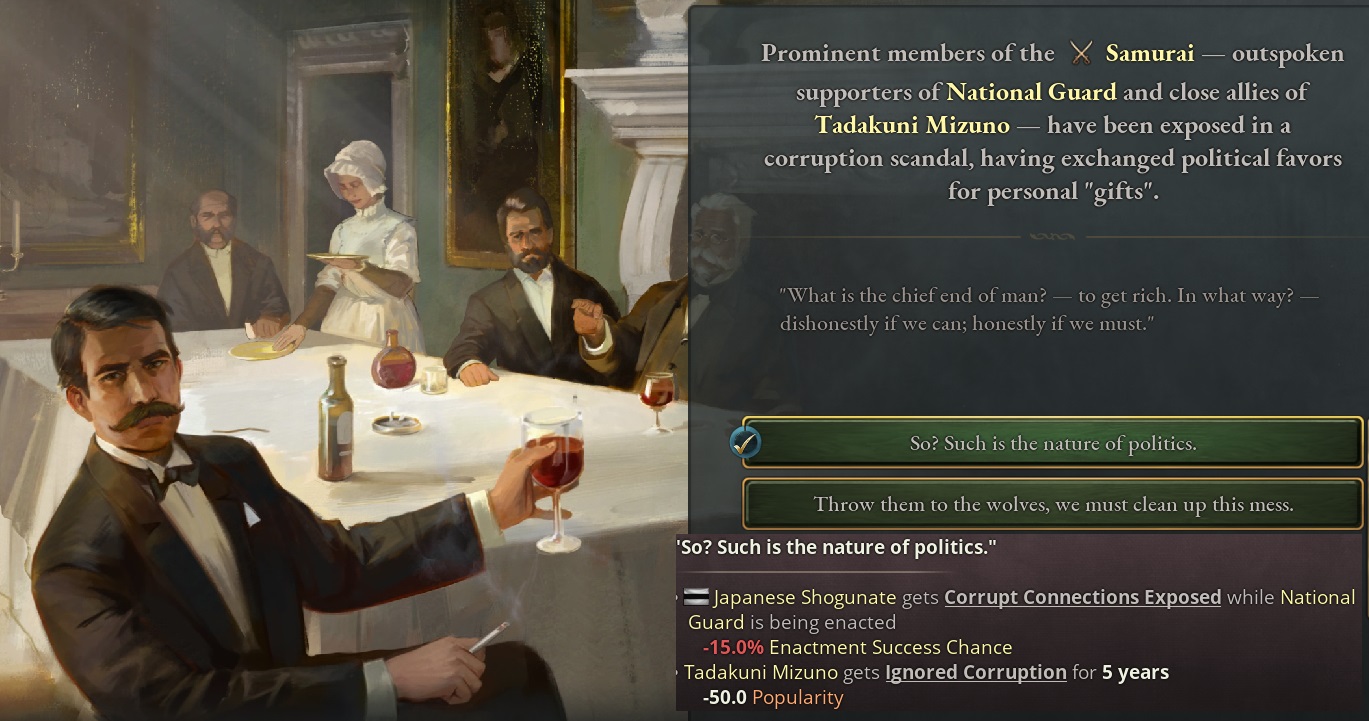
This did not turn out so well.
“So, what do we do?” asked Jin
“The implementation of the National Guard is... well, not as important,” replied Yoshimichi. “I suggest we scrap it- and go for a bigger prize.”
“Like?”
Now, for the first time in years, Yoshimichi hesitated. “Jin,” he started slowly.
“In order to topple the power of the shogunate, we need to diminish the power of daimyos. In order to do that, we have to create a system where other factions have power.”
Impatiently, Jin nodded. “We have been doing just that for years now, I know.”
“But one of the main power from daimyos comes from being the enforces of the all-mighty Shogun...” Yoshimichi continued.
“Yes, that is the... no, wait, you’re not proposing.. “ said Jin
“I’m afraid so,” replied Yoshimichi.
“Voting? Giving more power to the masses?” said Jin, looking shocked.
“Well, to select masses,” clarified Yoshimichi.
“But this will be almost impossible to take back- when I finally sit on the Chrysanthemum throne,” replied JIn.
“It can be doable,” replied Yoshimichi, “But I doubt this will end well.”
“But, Jin,” he continued. “Look at this this way. When you finally sit on the Chrysanthemum throne and rule as the all-mighty and all-powerful ruler, you need a class to rely upon to keep that power. Whatever you name it, it will be the new aristocracy. And in time, they will grow in power while yours weakens. Just like what happened to your ancestors. Just like what is happening to Tokugawas at the moment. It will be yet another cycle- one we can break by giving more base to your power.”
“While removing some of my future power,” Jin did not look convinced.
“Father,” for the first time, Asashi spoke up. Jin looked at him, curiously.
“Father,” the boy repeated. “Is it better to be an Emperor with no power, or an Emperor with limited power?”
“The boy has a point,” Jin conceded.
“Just, how are you going to convince the Shogun?”
“Not me,” Yoshimichi replied. “Kujo Tomonosuke.”

Industrialists going to government
“Who’s that?” Jin wondered
“Newest member of the Shogun’s cabinet. A smooth political operator. A new leader of the Industrialists. And yes, we are going to the government.”
“Hey, what about you? I thought you were...” Jin was shocked.
“I prefer to remain in the shadows. The open political landscape suits Kujo better,” replied Yoshimichi. “But I’ll be sure to bring Kujo with me for our next meeting.”
With it, Yoshimichi rose. Made a small bow towards Jin and his son and left. Again, the future of Japan changed a bit.
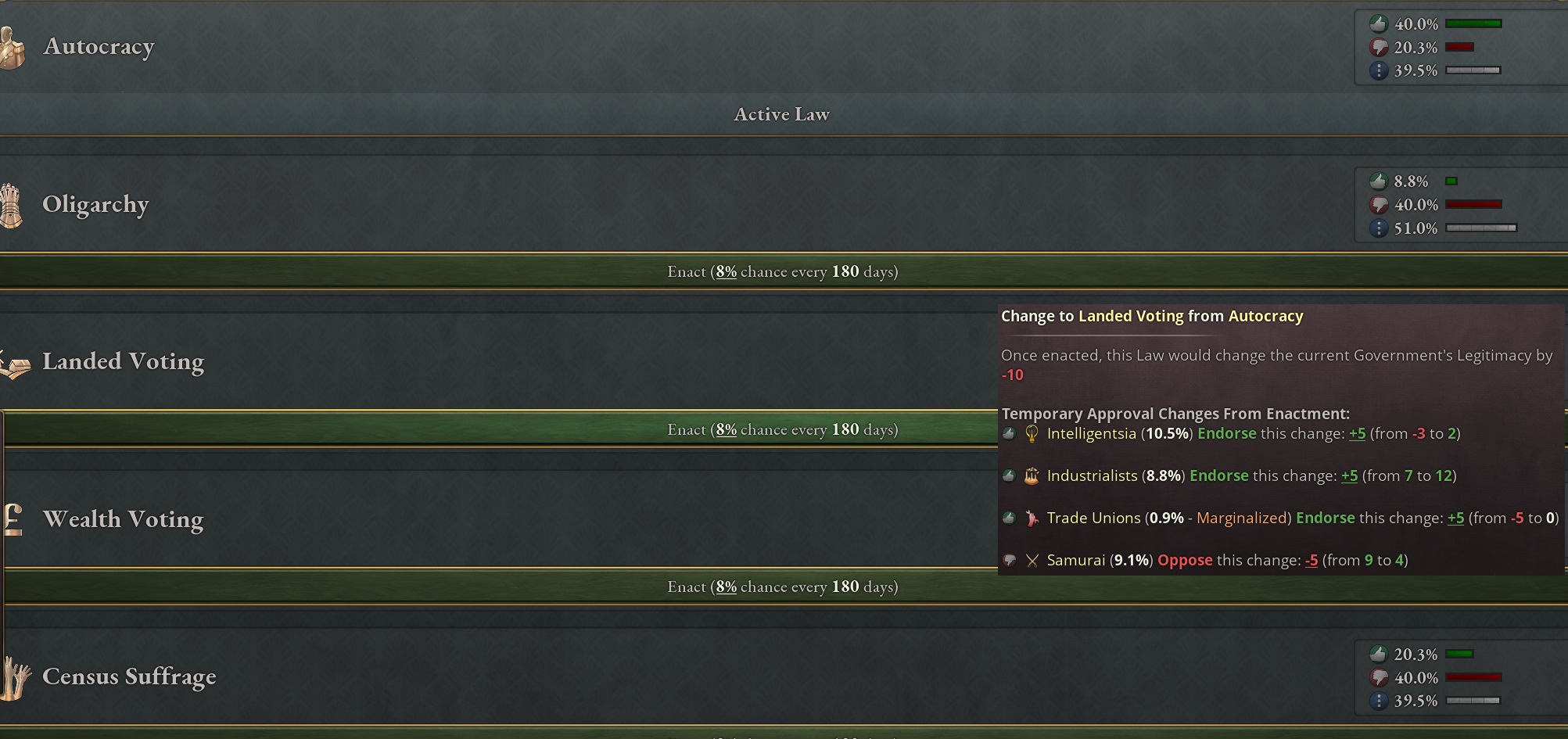
It is time for a major change
Bluffing Continues
With Borneo, or at least as much of it as possible, was under Japanese control, the Empire needed to turn their attention elsewhere. At least, until Japan can safely deal with the Dutch East Indies. And well, Indonesian islands just happened to have a few more suitable targets nearby. Java was Dutch, Celebs was uncivilized, but Sumatra was there and available. For the northern tip of the island was owned by Aceh and Siak, two independent and really small countries. And on 14th of March, 1842, Japan began to annex Aceh. Again, few units against the 100+ Japanese troops. It seemed hopeless and seeing several similar nations fall in Borneo, everyone thought the Japanese victory would be inevitable.
A bit over a month later, on 20th of April, Aceh rolled over in a speed that amazed even the Japanese. And Japan had another island. Well, part of an island, at least. This one was good as well. Had iron, sulphur and also, was a second source of sugar in the Japanese Empire.
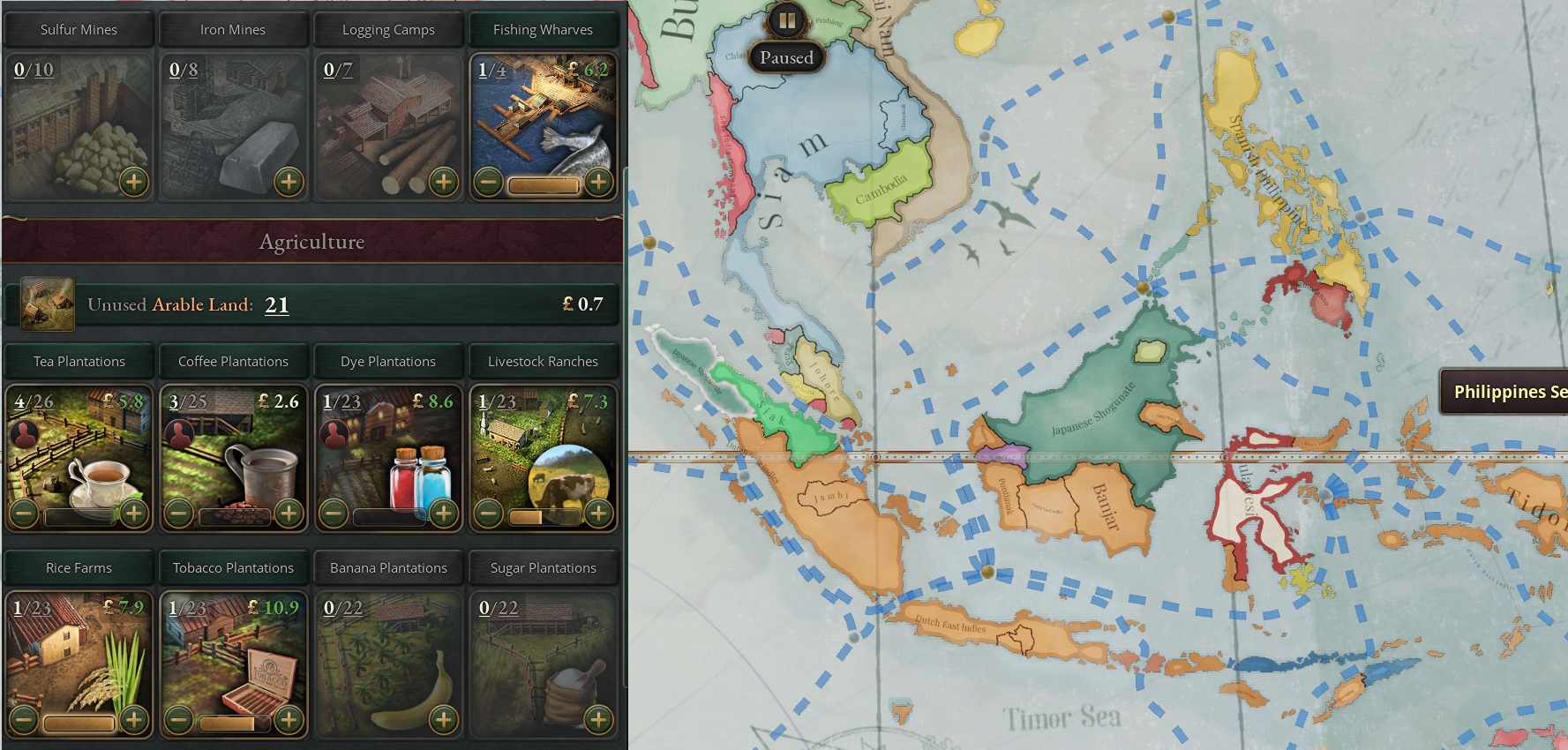
The next island
Russians are Coming
More worrying news arrived from the North this time. Russia, an Empire that stretches from the Pacific to Baltics, had decided to expand their territories. Right next door to Japan. On 27th April 1842 just a week after the Japanese were still celebrating the conquest of Aceh, news arrived from the north. Russia had settled a permanent colony on Sakhalin Island.
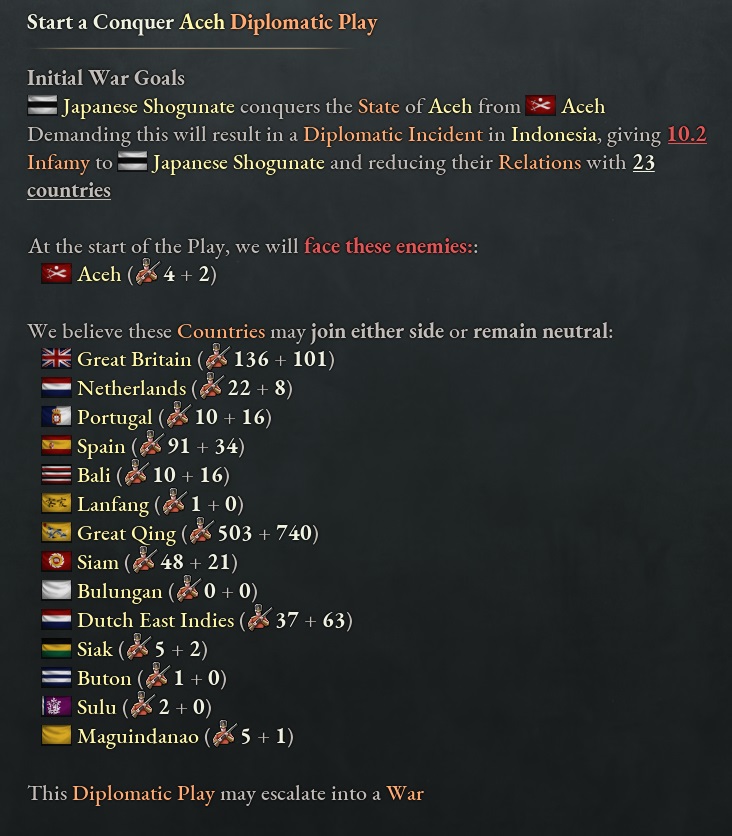
Still no navy
Japanese protests about expansion fell into deaf ears. In fact, it was predicted that soon, Russia will try the same with the northern part of Hokkaido, still disputed, though the Japanese thought of it as theirs.
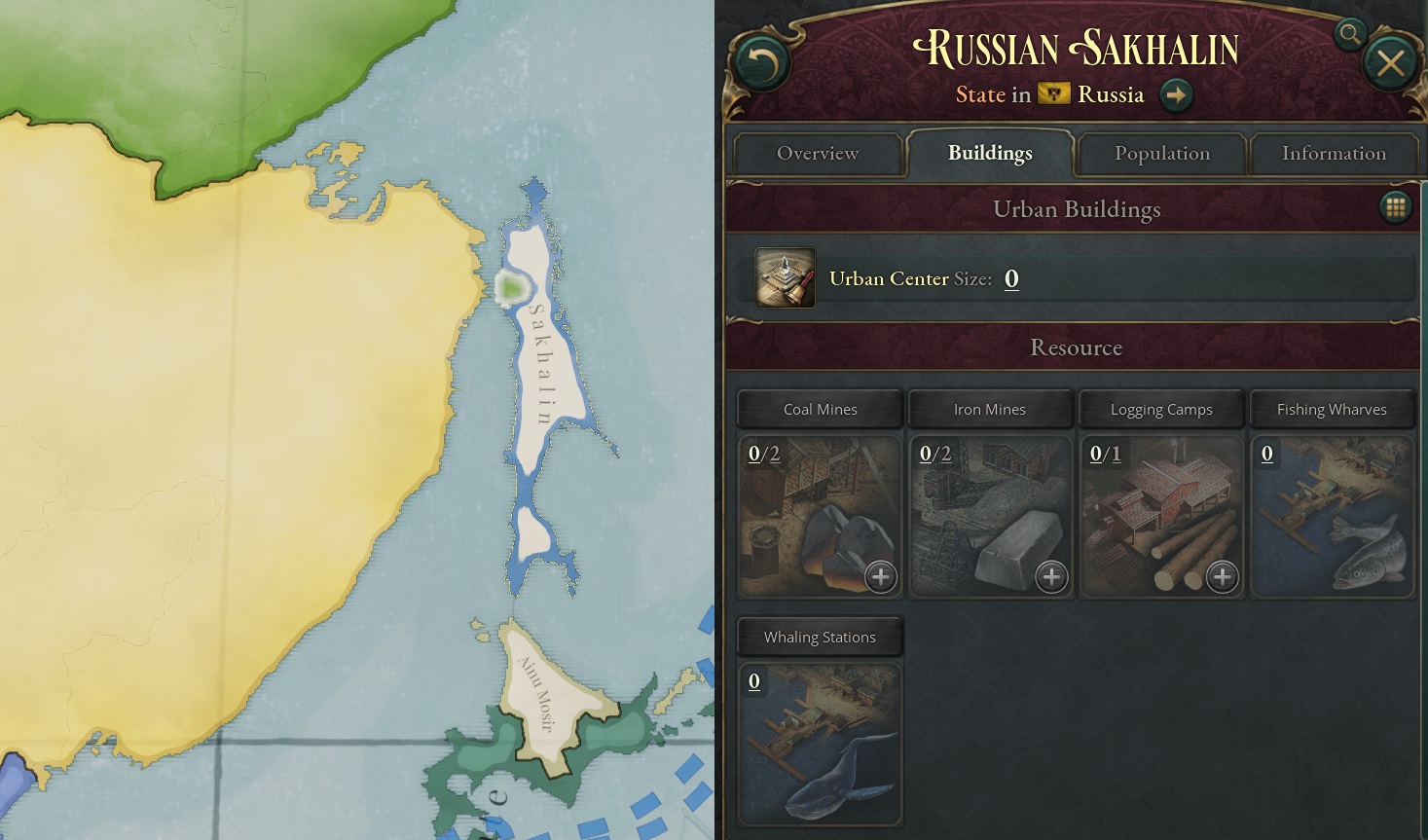
The Russians are coming!
On a bit brighter news, Japan got her first admiral. Jutoku Samanta, in August 1842. a member of the samurai. Commanding a mighty Japanese fleet of 1 ships- though to be fair, more were in their way. Japan had finally started to flex their muscles as a sea-faring nation.
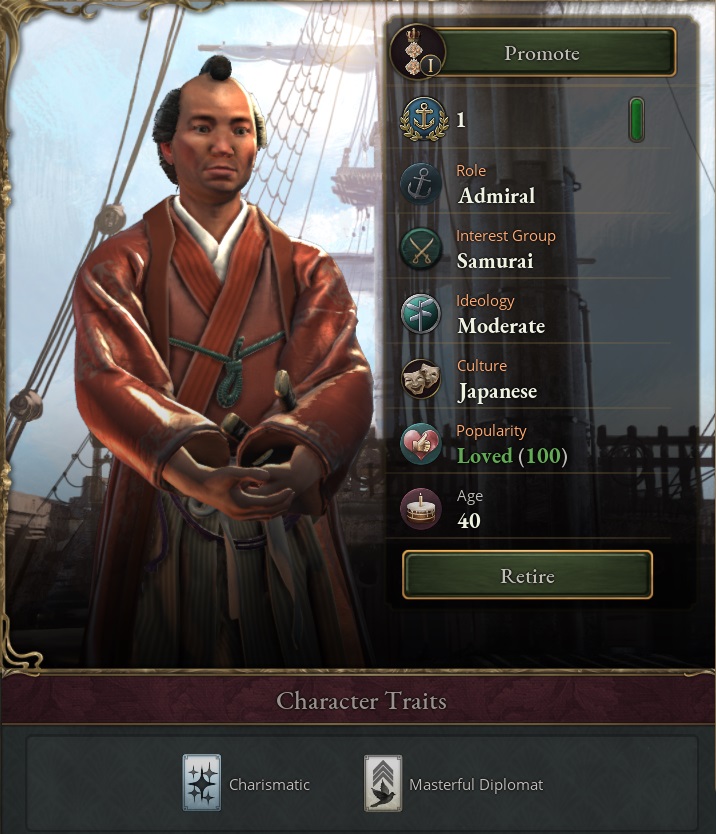
Admiral of a mighty Japanese fleet of 1 ships
And in July 1842, Japan had finally adopted atmospheric engines in all Japanese mines and all of these mines were making a hefty profit. The next step would be improving these engines, to be more efficient and allow even better production values. Th steam was coming to stay.
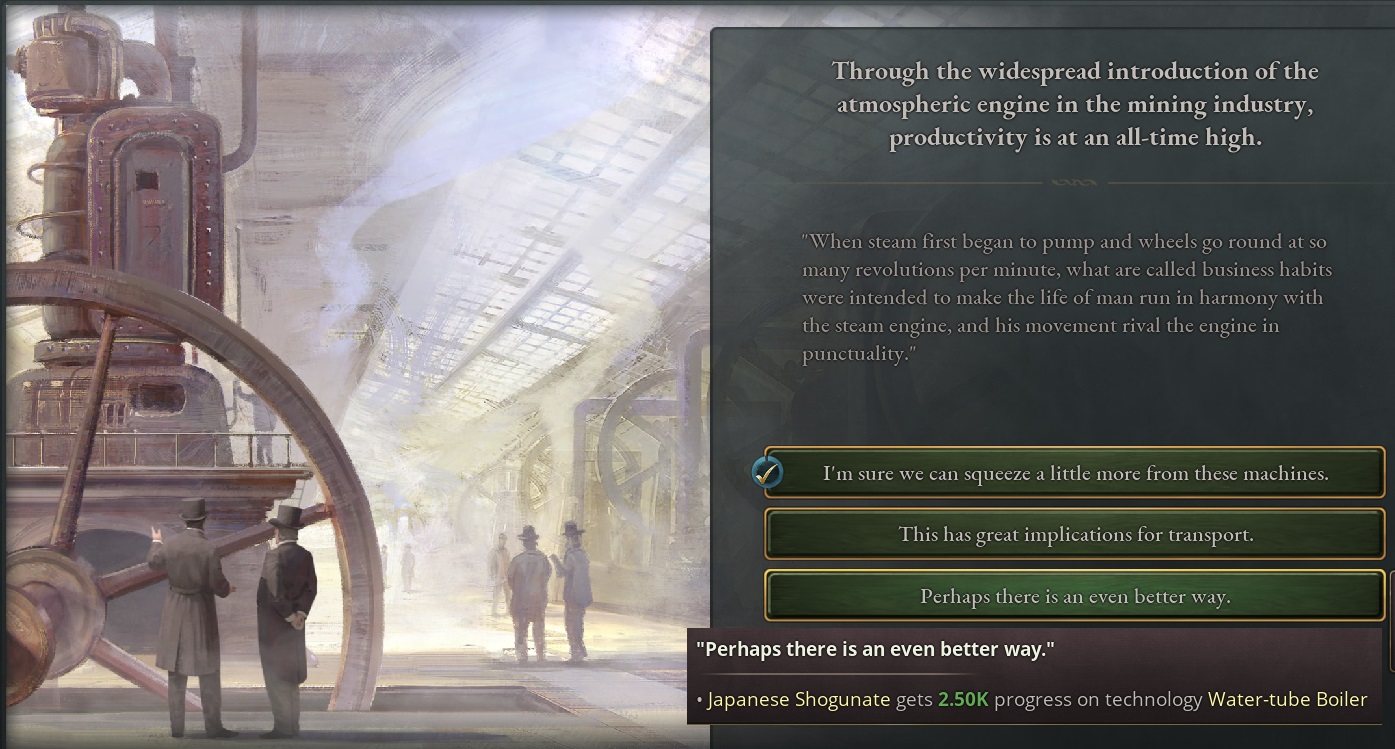
Steam, steam everywhere!
- 3

